December 01, 2009
KILDARE BOOK LAUNCH Wed 2nd DEC 2009
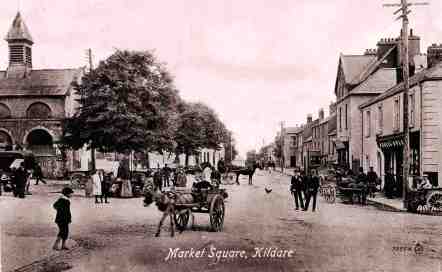
Cill Dara Historical Society
Kildare Town’s Local History Group
BOOK LAUNCH
Druim Criaig
The Ridge of Clay
A CONTRIBUTION TO THE HISTORY OF KILDARE TOWN
In
KILDARE EDUCATION CENTRE (Old Parochial House)
On
Wednesday 2nd December 2009
At
7 p.m.
ALL ARE WELCOME
Cill Dara Historical Society – Kildare Town’s Local History Group - has grown from strength to strength since its inception in 1989 and the monthly meetings are proving something of a focal point in the town. “The ‘cuppa and chat’ beforehand are probably as enticing as the actual content of the talk or presentation and as well as local subjects, it has expanded its remit to cover national and international topics and ventured into the unknown realms of storytelling and memorabilia,” says President, Mary D’Arcy. “Indeed our ‘Memories and Memorabilia’ night has allowed members and local people, who would not dream of giving a talk, an opportunity to participate and inform, and has become an extremely popular annual event.”
The partnership with Kildare Education Centre and the Society’s access to the wonderful facilities available in the Centre have been paramount in the growth and development of the Society and local history in the town.
A new partnership was forged in 2009 with the Kildare Nationalist when they began a series of weekly articles on Kildare, and the articles have proved so popular that the Society felt they needed to be brought together in a tangible way to preserve them, and also to make them even more widely available. The resulting publication, ‘DRUIM CRIAIG – The Ridge of Clay,’ will be launched on Wednesday night at 7 p.m. in Kildare Education Centre – All are Welcome.
Contributions from: Stephen Talbot, Mark McLoughlin, Adrian Mullowney, James Durney, Stephen Boland, Joe Connolly, Susan Waters, Mario Corrigan, Rory Hopkins, Brian Murphy, Fr. Adrian Carbery, and includes a complete reproduction of the
An Tóstal Souvenir Booklet of 1953.
The Ideal Christmas Stocking Filler!!
CONTENTS
Foreword
Acknowledgements
Introduction
Heritage Centre a good starting point
Children’s stories relating to St. Brigid
The Hundred Acres
The abbeys of Kildare
Going to the flicks
Kildare in 1846
The gentry, religious, traders and professionals in 1846
Monte Cassino and the Kildare connection: Part 1
Monte Cassino and the Kildare connection: Part 2
An eighteenth century Coffee House …
The Clubhouse as I recall it in the 1950s
Kildare electric lighting scheme
The Norman Castle of Kildare
Funeral of Commandant Seán Nolan
The Remains of St. Brigid
The White Abbey 1290-1798
Kildare Barracks - the early years
White Abbey 1800-1880
The Book of Kildare
White Abbey 1881-1890
Kildare Education Centre – former parochial house
Story of St. Brigid's Church
Executions marked the horror of bloody civil war
Bolands of Market Square…
Opening of St. Brigid's Park
In Search of a Grave - O'Grady, Grey Abbey
Tracing Your Ancestors
John Connolly, first County Librarian
The County Infirmary 1776-1903
The County Infirmary 1903-1960
Kildare in the Annals
A military man’s journey from Kildare to Korea
Schools in Kildare Town in 1824: Part One
Schools in Kildare Town in 1824: Part Two
The Civic Guards and the Kildare Mutiny
Kildare Townlands
Kildare DC Electric Station
A forgotten All-Ireland!
The Story of Agatha…
From Chaplin’s Field to Rowanville
Rowanville and Rowan Villas
Kildare Town’s first hotel?
James Patrick Belford
A poem for Christmas
The ‘Biller’ was special…
An Tóstal Souvenir Booklet 1953
An Tóstal Programme 1954 of Historical Pageant
Index
Posted by mariocorrigan at 02:45 PM
May 28, 2009
FOURTH ANNUAL BOOK FAIR
2009 RARE BOOKS FAIR, CLASSIC CARS, and FREE GUIDED WALKING TOUR
KILDARE TOWN
Sunday 31st May
FOURTH COUNTY KILDARE BOOK FAIR!
The fourth County Kildare Book Fair will take place on Sunday afternoon, the 31st May in Kildare Town. This will be an opportunity for those interested in history and heritage as well as the general population who are interested in books and reading in general to visit a Rare Books Fair outside of Dublin. It is being organised by the Kildare Collections and Research Services, Kildare County Library and Arts Service in conjunction with Kildare Town Heritage Centre, Kildare Parish Centre, Kildare County Council, the Kildare Classic Car Association and Lyonshill Books. According to Local Studies Librarian, Mario Corrigan, "there is an enormous interest in Dublin and other areas in this sort of event and after the success of the first three County Kildare Book Fairs 2006 - 2008 we in County Kildare are looking forward to the event. It is an ideal opportunity also for anyone who has not yet visited the Kildare Retail Outlet Village to come to the town and see what is on offer."
The main event is free and open to all and will allow people to browse the books on offer in The Kildare Parish Centre. "The idea is to encourage people to walk through Kildare Town, visit Kildare Cathedral and thoroughly enjoy the day," said Mario Corrigan who has published a Sli na Slainte and Heritage Trail of Kildare Town and is anxious that people enjoy the experience that Kildare, the Heritage Town has to offer. This year there will also be the added attraction of a free Walking Tour of Kildare Town at 1 p.m.
Eddie Murphy of Lyonshill Books is delighted to be able to add County Kildare to a growing list of Book Fairs that he and his colleagues have orchestrated. "It is an immensely pleasurable experience, whereby people can browse the stalls and hopefully with this new initiative in Kildare Town take in some of the rich heritage of such an historic setting - maybe pause in the local shops or the local cafes and pubs for a coffee and even visit the Outlet Village for a unique shopping experience. We do hope this year proves to be as successful as last year when we had a great turn out," said Mr. Murphy.
So why not take an afternoon break on Sunday 31st May and come to Kildare Town to the County's Rare Books Fair - maybe in search of a unique gift or just to amble through the historic streets and enjoy the experience. Why not enjoy the unique shopping experience that is ‘Kildare Retail Outlet Village,’ and Kildare Town Heritage Centre has a host of collectibles and gift ideas to wet your appetite.
The Kildare Classic and Vintage Car Association will be on-hand as Sunday 31st May is the date for their annual Gordon Bennett Commemorative Rally and the cars will be parked on the Market Square during the afternoon – most of the cars arriving around 3 pm. All in all it is an ideal day out.
THOUSANDS OF BOOKS, RARE, ANTIQUARIAN AND LOTS OF BARGAINS -FREE VALUATIONS !!!
Posted by mariocorrigan at 12:36 PM
July 08, 2008
LAUNCH OF NEW BOOK - LEWIS'S TOPOGRAPHICAL DICTIONARY OF CO. KILDARE IN 1837
Kildare County Library, Local Studies, Genealogy and Archives Dept. in partnership with Kildare Town Heritage Centre have recently launched 'A Topographical Dictionary of County Kildare in 1837' being the relevant 'Kildare' extracts from Samuel Lewis's Topographical Dictionary of Ireland published in that year. It has been re-edited since the material was first made available on the internet, corrected and material added and now appears with almost 1300 references in the comprehensive index as well as a glossary and the original parameters for the survey as set out in the Leinster Express of 1834. It was compiled by Mario Corrigan, Niamh McCabe and Michael Kavanagh.
The book is on sale at Farrells of Newbridge, Barker and Jones in Naas, Kildare Town and Athy Heritage Centres, Malones Newsagents in Kildare and Kildare Outlet Shopping (Kildare Retail Village) and is priced at €15.99
ALL PROCEEDS WILL GO TO KILDARE TOWN HERITAGE CENTRE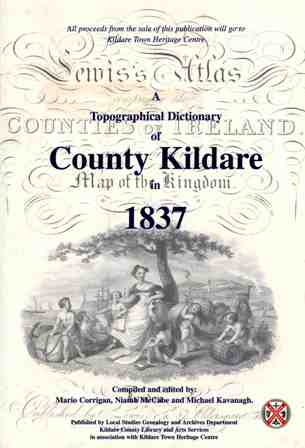 Below is an extract from the book re. County Kildare
Below is an extract from the book re. County Kildare
KILDARE (County of), an inland county of the province of Leinster, bounded on the east by the counties of Dublin and Wicklow, on the north by Meath, on the west by the King’s and Queen’s counties, and on the south by Carlow. It comprises an area, according to the Ordnance survey, of 392,435 acres, of which 325,988 are cultivated ground, and 66,447 are unprofitable mountain and bog. The population, in 1821, amounted to 99,065, and in 1831, to 108,424.
This county is partly within the diocese of Dublin but chiefly in that of Kildare. For purposes of civil jurisdiction it is divided into the baronies of Carbery, Clane, Connell, Ikeathy and Oughterany, Kilcullen, Kilkea and Moone, East Narragh and Rheban, West Narragh and Rheban, East Ophaly, West Ophaly, North Naas, South Naas, North Salt, and South Salt.
It contains the incorporated assize and market towns of Naas and Athy; the ancient disfranchised borough and market town of Kildare; the market and post-towns of Kilcock, Maynooth, Celbridge, Monastereven,Timoline, Rathangan, Leixlip, Kilcullen-Bridge, and Newbridge; and the post-towns of Castledermot, Clane and Ballytore: the largest villages are Prosperous, Kill, Johnstown-Bridge, and Sallins. Prior to the Union it sent ten members to the Irish parliament. The election, if held between the spring and summer assizes, takes place at Naas; if at any other period of the year, at Athy.
The county is included in the home circuit: the spring assize is held at Naas, and the summer assize at Athy, at each of which are a county court-house and gaol. The general quarter sessions are held at Athy and Maynooth in January, at Kildare and Naas in April, at Maynooth and Athy in July, and at Naas and Kildare in October. The number of persons charged with criminal offences and committed to the two prisons, in 1835, was 101, and of civil bill committals, 22.
The local government is vested in a lieutenant, 12 deputy-lieutenants, and 92 magistrates, with the usual county officers, including two coroners. There are 45 constabulary police stations, having in the whole a force of one stipendiary magistrate, 4 chief and 40 subordinate constables, and 205 men, with 6 horses the expense of whose maintenance is defrayed equally by Grand Jury presentments and by Government. The district lunatic asylum for the county is at Carlow, and the county infirmary at Kildare: there are fever hospitals at Celbridge, Naas, and Kilcullen, and dispensaries at Athy, Ballitore, Castledermot, Celbridge, Clane, Donadea, Johnstown-Bridge, Kilcock, Kilcullen, Maynooth, Monasterevan, Naas, Newbridge, Rathangan, and Robertstown; the infirmary and fever hospitals are supported by Grand Jury presentments, and the dispensaries by equal presentments and voluntary subscriptions. The amount of the Grand Jury presentments for 1835 was £19,554. 18. 9., of which £1221. 7. 10. was for the public roads of the county at large; £6051. 12. 5. for the public roads, being the baronial charge; £5206. 7. 8. for public establishments, officers’ salaries, buildings, &c.; £4713. 15. 10½. for police, and £2304. 14. 11½. in repayment of loans advanced by Government. In the military arrangements it is included in the eastern district, and contains three barrack stations, two for cavalry at Newbridge and Athy, and one for infantry at Naas.
The general surface is rather level. In the barony of West Ophaly are several gently rising hills, and others occur towards the eastern boundary of the county. The greatest elevation of the plain country is around Naas, both which baronies and their vicinity present an appearance of great fertility, which is also exhibited generally throughout the eastern and southern, and a portion of the western parts of the county; but towards the north and north-west are vast tracts of the Bog of Allen, comprising more than 50,000 acres, having a flat, dreary surface, relieved here and there by verdant elevations, here called “islands.” Near the southern extremity of this immense bog are the hills of Grange Allen, Cheelow, Dunmurry, Redhills, and Knocknagylogh, generally fertile, and cultivated to the summit. There are also small hills in the vicinity of Timoline and Moone; others stretching from Killan, by Kilrush, Davidstown, Calverstown, and Thomastown, and terminating in the hills of old Kilcullen and Ballysax; and other small and detached elevations near Arthurstown, Lyons, Longtown, &c. The Bog of Allen and the Curragh of Kildare are two distinguishing features of the county.
Towards the west rises the Hill of Allen, a steep elevation of a conical form, about 300 feet in height. The Curragh is a fine undulating down, six miles long and two broad: it lies in a direction from north-east to south-west, having the town of Kildare near its western extremity, and crossed by the great road from Dublin to Limerick; and is, in fact, an extensive sheepwalk of above 6000 acres, forming a more beautiful lawn than the hand of art ever made. Nothing can exceed the extreme softness and elasticity of the turf, which is of a verdure that charms the eye, and is still further set off by the gentle inequality of the surface: the soil is a fine dry loam on a substratum of limestone. It is depastured by numerous large flocks turned on it by the occupiers of the adjacent farms, who alone have the right of pasture, which greatly enhances the value of these farms. This plain has long been celebrated as the principal race-ground in Ireland, and is equal, if not superior, to that of Newmarket, in all the requisites for this sport.
In general the county is fertile and well cultivated, particularly around Athy, and thence along the banks of the Barrow, extending to the borders of the county of Carlow. The districts around the towns of Kildare, Naas, Kill, and Clane are also fertile, well fenced, and tolerably well cultivated; but in wet seasons much water remains on the surface, showing the want of a good system of drainage, which is much neglected. Agriculture is systematically practised in some parts, particularly by the noblemen and resident gentlemen, and their example is beginning to produce its beneficial effects among the small farmers. Wheat is cultivated generally, and the quality is remarkably good; the barley is also bright and sound; the oats are good, clean and heavy, except in a few low, cold, and clayey situations; potatoes are extensively grown, and in great varieties of sorts, large quantities being sent to Dublin; turnips and mangelwurzel are cultivated by a great number of the wealthy farmers, clover and vetches by nearly all; and rape is grown extensively around Monastereven.
The Scotch plough is general, the old heavy wooden plough being rarely seen; indeed agricultural implements of all kinds are greatly improved, except the spade, which is still a long narrow tool. The heavy wooden wheel car has given place to one of much lighter construction, with low spoke-wheels, iron-bound, the kish, so general in the western counties, is scarcely ever seen here; some of the vehicles are made exactly after the plan of the Scotch cart, some of them with, and some without the high sides. Greater attention is manifested in collecting manure, and large composts are raised in the vicinity of bogs by the mixture of bog mould and stable manure or ashes. The burning of subsoil in kilns was introduced by the late Mr. Rawson, who compiled the statistical survey of Kildare for the Royal Dublin Society, and has now become general, producing the finest crops of potatoes and turnips. A kind of indurated sand found in banks, the adhesive property of which is so great that the bank, when cut perpendicularly, will never yield in any kind of weather, is considered by some agriculturists as a kind of golden mine for the farmer who can avail himself of the benefit of it. The cottagers in the neighbourhood of the Curragh collect the sheep dung, which they mix in tubs with water, stirring it until it forms a thick solution, which they call “mulch;” in this they steep the roots of their cabbage plants for some hours; a quantity of the substance consequently sticks to the roots, and ensures a full crop. In the smaller farms a very disadvantageous custom is prevalent of dividing the land into long narrow enclosures, which occasions an unnecessary and therefore injurious extent of fence in proportion to the land included. The fences generally are tolerably good, but they everywhere occupy too much ground; the usual kind is a bank of earth thrown up from a wide ditch, and covering five or six feet of surface, so that the bank and ditch seldom occupy less than nine feet in width: in the breast of this bank, about halfway up, a single row of quicksets is placed, sometimes accompanied by seedlings of forest timber.
In those parts which have not been subjected to tillage there are very rich fattening grounds; but where the soil has been much exhausted by the plough, the pasture is poor and light. The grasses in the meadows and feeding pastures are of the most valuable kinds; in low bottoms, especially in those subject to floods, Timothy grass is the principal herbage. Dairies of any extent are not frequent, except in the parts convenient to the Dublin market, where they are kept for the purpose of fattening calves. Great improvement has been made in the breed of cattle, the old long-horned Irish cow being now rarely seen; the most esteemed are the short-horned or Dutch breed, crossed with the Durham; some of the gentry and wealthy farmers have introduced the pure Durham breed, which commands large prices; others have the North Devon, which answers remarkably well. The small farmers mostly prefer the old Irish long-horned cow, crossed with the Durham; and in some districts scarce any other is seen: in the northern baronies, bordering on Meath, the large and heavy long-horned cattle are very common and grow to a size equal to those of Meath or Westmeath. Great numbers of cattle are brought from other counties, and fed here for the Dublin market. Great improvement has been made in the breed of sheep, and vast flocks are every year reared on the Curragh: the most prevailing breed is a cross between the New Leicester and the Ayrshire, but many of the principal agriculturists have the pure New Leicester; sometimes they are crossed with the Kerry sheep. The lower class of farmers have brood mares as part of their tillage stock, but they do not pay sufficient attention to the breed of the sires, and are too desirous of crossing with racers. Planting has been carried on for many years extensively and successfully. Many of the demesnes are ornamented with full-grown timber. The timber sallow thrives particularly well in the wet grounds with which the county abounds; beech and larch are also of very quick growth. In the demesne of Moore Abbey is one of the best-planted hills in Ireland; and the woods of Carton and Palmerstown are extensive, and the timber remarkably fine. In draining the bogs remains of ancient forests have been discovered.
The great mountain range of granite of which the county of Wicklow is nearly composed, terminates in this county at Castledermot. Thence by Ballitore, Kilcullen, and to the south-east of Naas, nearly as far as Rathcoole, is clay-slate; the rest of the county belongs to the great field of floetz limestone which covers the greater part of the flat country of Ireland, and which is here interrupted only by the chain of central hills. The low group of hills west of Rathcoole, which includes Windmill Hill, Athgoe, Lyons, and Rusty Hill, is composed of clay-slate, grauwacke, grauwacke-slate, and granite. The grauwacke consists of small and finely rounded and angular grains of quartz, numerous minute scales of mica, small fragments of clay-slate, and sometimes portions of felspar. The rock at Windmill Hill ranges 10onorth of east and south of west, which is the general direction of these hills, exhibiting also at times an undulating curved slaty formation: the dip is towards the south-west, and generally at an angle of about 45o. The grauwacke-slate of Windmill Hill is remarkable for containing subordinate beds of granite, the uppermost at the depth of four fathoms; they are 50 or 60 yards apart, separated by the grauwacke-slate, and all dip from 45o to 50o to the south-east. Some of these granite beds may be traced westward to the turnpike road opposite to Rusty Hill: they consist of a small and finely grained intermixture of yellowish and greyish white felspar, greyish vitreous transparent quartz, and flakes or scales of mica, white and silvery, with some scattered portions of schorl: the grains are sometimes so minute that the stone appears almost compact. Sometimes also small particles and cubical crystals of iron pyrites are disseminated through the rock, which, when decomposing, communicate an iron-shot spotted appearance to the stone. The red sandstone conglomerate occurs in situ at the northern foot of the Hill of Lyons, where it is exposed for about 10 fathoms in length, in strata four feet thick, ranging east and west, dipping 30o to the north, and resting on grauwacke-slate; it re-appears in the central range. Red Hill, Dunmurry Hill, and the western foot of Grange Hill, consist of alternating beds of finely grained grauwacke, grauwacke-slate, and clay-slate, ranging 10o north of east and south of west, and dipping 60o towards the south-east, but in many places being nearly vertical. At the northern foot of Red Hill is a small patch of red sandstone conglomerate, which was quarried for mill-stone some years since. Enough of the firm rock is visible to show that the strata range east and west, and dip 17o west. The Chair of Kildare consists of floetz limestone, extending southwards to the northern foot of Dunmurry Hill, and covering the grauwacke and slaty rocks. To the north it rests on the trap of Grange Hill, which also covers the same kind of rock.
The Hill of Allen is separated from Grange Hill by an intervening vale, their summits being about two miles apart: it is composed of one great body of granular and compact greenstone and greenstone porphyry, which appears all round the base, on the sides, and on the summit, in numerous protuberant rocky masses, without any mark of stratification. Some of the greenstone is remarkably crystalline, consisting of large masses of hornblende, with crystals of felspar. Whether this hill be a distinct mass or connected with Grange Hill is not easily ascertained, from the depth of the alluvial soil. About a quarter of a mile from the northern extremity of the Hill of Allen is a slight eminence called the Leap of Allen, composed of red sandstone conglomerate, arranged in beds which vary from 9 to 18 inches and even to 2½ feet thick, and are separated by thin layers of reddish sandy slate-clay. It contains the same components as the conglomerate already noticed, with the addition of fragments of grauwacke-slate, which are, however, comparatively rare: it is quarried for mill-stones. The beds range north-north-east and south-south-west, dipping south-south-east at an angle of from 15o to 20o, and therefore they probably underlie and support the trap of the Hill of Allen. Indications of copper having been observed in the Dunmurry hills, miners were employed to explore them in 1786, during whose operations detached masses of sulphuret of copper were found of nearly 40 per cent. purity, accompanied with a strong vitriolic water: the principal bed seemed to lie deep in the hill, and even to dip under the adjoining valley. Near the base of the hill was also found an alkaline argillaceous earth of a light grey colour, possessing many of the qualities of fullers’ earth. In the veins of the rocks, and in the matrix of the ore, were quantities of fine yellow ochre proper for painting. The surface of the Hill of Allen also presents indications of copper. The loose stones and the projecting points of rock appear as if vitrified by fire, and in many places impregnated with carbonate of copper.
Several attempts were made near the close of the last century to establish the cotton manufacture, and some large mills were built near Clane, Leixlip, and other places, but they all fell to decay. A very large mill for manufacturing cotton was, however, built a few years since at Inchyguire, near Ballytore, which is still in full operation; and a small woollen manufacture is carried on at Celbridge. These are the only manufactures of note which the county possesses, although the numerous falls on the rivers offer most advantageous sites for the erection of works, and there is a great facility for the transit of goods. Though all the small rivers abound with trout, and though the Barrow formerly gave a copious supply of salmon, yet there are no fisheries. The weirs thrown across this river for forming mill-dams have presented such impediments to the passage of the fish, that they are nearly banished from it.
The river Boyne has its source in the northern part of the county, as also has its tributary branch the Blackwater. The Barrow forms the greater part of the western boundary, being joined in its course by the Feagile, the Little Barrow, the Finnery, the Grees, and the Ler (or Lune), all from the east; the Liffey trenches deeply into the eastern part, receiving at Leixlip the Ryewater, which forms part of the northern boundary, and its tributary the Lyreen; it also receives the Morrel between Celbridge and Clane. The Grand Canal enters this county near Lyons, nine miles from Dublin, and quits it for the King’s county near the source of the Boyne, in the Bog of Allen. Near Sallins it is carried over the Liffey by an elegant aqueduct, whence a branch leads to the town of Naas, and thence is another branch to Harbourstown, in the direction of Kilcullen, which was intended to have been continued to Wexford. From Robertstown, just where the canal enters the Bog of Allen, a branch diverges, and passing through the Queen’s county falls into the Barrow at Athy, opening a communication with Carlow, New Ross, and Waterford. From this line a branch, called the Miltown Canal, leaves it near Robertstown, and proceeds in the direction of the Curragh; and at Monastereven, where the Athy line crosses the Barrow by a noble aqueduct, another branch leaves it for Portarlington and Mountmellick. The summit level is in this county, from which each branch is amply supplied with water in the driest seasons without the expense of a reservoir. The Royal Canal enters near Leixlip, seven miles from Dublin, and passes a little south of Maynooth and Kilcock to Nicholastown, near which it leaves this county and enters Meath: it re-enters it by an aqueduct over the Blackwater, and continues to the Boyne, over which it is conveyed by an aqueduct, and again enters Meath near Clonard.
Among the existing relics of antiquity are five ancient round towers, situated at Kildare, Taghadoe, Kilcullen, Oughterard, and Castledermot; the first is the most remarkable. Raths are numerous. Three miles south-east of Athy, that called the Moat of Ardscull stands prominent. A mile farther is the Hill of Carmon, which was the Naasteighan, or place where the assembly of the states of the southern part of Leinster was held: near it are sixteen smaller conical hills, supposed to be the seats on which the elders sat. Near the rath is a single pillar stone, called Gobhlan, about seven feet high, supposed to have been erected for the worship of Baal. Stones similar to that at Mullimast are to be seen at Kilgowan, Furnace, and Punch’s Town, all in the vicinity of Naas. At Harristown, near Kilcullen, is another of those taper upright stones, with a conical top; and about two miles from Jigginstown are two others, known by the name of the Long Stones. The rath of Knock-Caellagh, near Kilcullen, consists of a tumulus surrounded by a circular intrenchment, 20 feet wide and ten deep, with a rampart outside the trench. Cromwell is said to have encamped here on his way to the south. Others less remarkable, yet worthy of notice, are to be seen near Rheban, two miles north of Athy, at Kildare, at Naas, near Kilkea Castle, at Moon, at Clane, at Lyons (across which the boundary line of the counties of Kildare and Dublin passes), and at Rathsallagh, near Duncavan. On the Curragh are numerous earthworks, most of which appear to be sepulchral, forming a chain of fourteen small raths or circular intrenchments without ramparts, in a line of nearly three miles, extending east and west. A tradition has long prevailed of a stupendous heathen monument of huge stones existing here; but no vestige of it can now be discovered.
There were many celebrated and richly endowed monastic institutions in the county. At Athy was one for Crouched friars and another for Dominicans. Castledermot possessed a priory for Regular canons, a house of Crouched friars, and a Franciscan abbey, the ruins of which still serve to attest its former magnificence. The ruins of another Franciscan abbey are to be seen at Clane, where there was also a house of Regular canons. At Graney are the ruins of an Augustinian nunnery. A gateway and some other remains of a monastic building, said to have belonged to the Knights Templars, are still shown there. The ruins of Great Connell abbey are on the banks of the Liffey, near Newbridge. In Kildare was a nunnery and abbey united, founded by St. Brigid, and of which the ruins are still pointed out; also an abbey of Grey friars, situated south of the town, and a house of Carmelites or White friars. At Old Kilcullen is a monastery as old as the time of St. Patrick, which in 1115 was elevated to the dignity of an episcopal see, but it does not appear that it long retained that rank. Near the ruins of the old church are the remains of two crosses, one of which still retains some very curious specimens of ancient sculpture. Maynooth had a convent of Black nuns, and a college of priests founded by the Earl of Kildare; the abbey of Killossy has been converted into the parish church, and is remarkable for the singularity of the architecture of its steeple tower; the monastery of Kilrush was surrounded by a broad ditch faced with masonry ten feet high; the abbey of Monastereven has been converted into the residence of the Moore family, the representative of which is the Marquess of Drogheda. At Moone was a Franciscan friary, the brotherhood of which retained possession of it subsequently to the Reformation. Here is a fragment of a very old cross, one of the most curious in Ireland, covered with numerous grotesque figures. In Naas were three religious establishments, namely, a convent of Augustinians, another of Dominicans, and one for friars eremites of the order of St. Augustine. Some remains of the buildings of New Abbey, on the banks of the Liffey, are still to be seen; and of St. Wolstan’s, also on the Liffey, near Celbridge, two towers and two gateways yet exist. Timolin had a monastery of Regular canons, and also a nunnery; at Tully, a mile south of Kildare, was a commandery of the Knights Templars, the possessions of which are held in commendam with the bishoprick of Kildare; the abbeys of Clonagh, Cloncurry, Disert-Fulertagh, Glasnaoidhun, Grangenolvin, Kilbeggs, Knocknacrioth, Lexlip, and Tulachfobhair, are known only by name.
The remains of many castles are scattered through the county: the principal were Kilkea, Athy, Castledermot, Rheban, Kilberry, Woodstock, Timolin, Castle Carbery, Ballyteague, Clane, Rathcoffy, Donadea, Lackagh, Kildare, Leixlip, Corifig, Morrestown-Nenagh, Cloncurry, and Maynooth. The modern mansions of the nobility and gentry are noticed in the parishes in which they are respectively situated. The farm-houses in general consist of a long thatched building of one story, containing in the centre a large kitchen, with lodging-rooms at each end: the front door opens into a yard, here called a bawn, on the sides of which are the out-buildings. The cottiers’ cabins exhibit a mode of construction different from that of the more northern districts; the lower half being built of stone and clay mortar, and the upper of clay or sods, topped with a thick covering of straw thatch. Oatmeal, potatoes, herrings, and some milk and butter, constitute the food of the poorer class; their fuel is turf; their clothing principally home-made frieze. Even in the midst of summer a heavy frieze loose coat, called a “trusty,” is worn over the rest of the garments. The dress of the women is much better than it formerly was. The circumstances and appearance of the population located on the bogs, or their immediate vicinity, are very unfavourable. On each side of those parts of the canal that pass through the bog, the land is let in small lots to turf-cutters, who take up their residence on the spot, however dreary and uncomfortable. Their first care is to excavate a site for a habitation on the driest bank that can be selected, which is sunk so deep that little more than the roof is visible; this is covered with scanty thatch, or, more frequently, with turf pared from the bog, laid with the herbage upwards, which so perfectly assimilates with the aspect of the surrounding scenery that the eye would pass it over unnoticed, were it not undeceived by the appearance of children and domestic animals sallying from a hole in one side, and by the occasional gush of smoke from the numerous chinks in the roof. The English language is everywhere spoken. The customs of gossipred and fosterage are closely adhered to. Gossips will fight most pertinaciously for each other; in all conversations they call each other by the endearing name; and not to have gossips at baptism would cast a deep reflection on the parents.
Posted by mariocorrigan at 11:16 PM
May 20, 2008
BOOK FAIR, BOOK LAUNCH and GORDON BENNETT CLASSIC CAR RUN - KILDARE TOWN SUNDAY 1st JUNE
THIRD ANNUAL COUNTY BOOK FAIR
(Kildare Parish Centre)
GORDON BENNETT CLASSIC CAR RUN
(Kildare Market Square)
and
BOOK LAUNCH at 3 PM
'A Topographical Dictionary of Co. Kildare in 1837'
(Kildare Town Heritage Centre)
KILDARE TOWN
Sunday 1st JUNE 1 - 5 PM
Guided Walking Tour of Kildare Town 1 PM - €3
( places can be pre-booked through Kildare Town Heritage Centre)
2008 RARE BOOKS FAIR, CLASSIC CARS, GUIDED WALKING TOUR AND BOOK LAUNCH
KILDARE
TOWN
Sunday 1st June
THIRD
COUNTY
KILDARE BOOK FAIR!
The third
County
Kildare
Book Fair will take place on Sunday afternoon on the 1st June in
Kildare
Town
. This will be an opportunity for those interested in Local History and heritage as well as the general population who are interested in books and reading in general to visit a Rare Books Fair outside of
Dublin
. It is being organised by the Local Studies, Genealogy and Archives Department of Kildare County Library and Arts Service in conjunction with Kildare Town Heritage Centre, Kildare Parish Centre, Kildare County Council, the Kildare Classic Car Association and Lyonshill Books. According to Local Studies Librarian, Mario Corrigan, "there is an enormous interest in Dublin and other areas in this sort of event and after the success of the first two
County
Kildare
Book Fairs in 2006 and 2007 we in
County
Kildare
people in the county are looking forward to the event. It is an ideal opportunity also for anyone who has not yet visited the
Kildare
Retail
Outlet
Village
to come to the town and see what is on offer."
The main event is free and open to all and will allow people to browse the books on offer in The Kildare Parish Centre. "The idea behind the two venues is to encourage people to walk through Kildare Town, visit Kildare Cathedral and thoroughly enjoy the day," said Mario Corrigan who has published a Sli na Slainte and Heritage Trail of Kildare Town and is anxious that people enjoy the experience that Kildare, the Heritage Town has to offer. This year there will also be the added attraction of a Walking Tour of
Kildare
Town
at 1 p.m. – places can be pre-booked through the Heritage Centre and price for the tour is €3.
Eddie Murphy of Lyonshill Books is delighted to be able to add
County
Kildare
to a growing list of Book Fairs that he and his colleagues have orchestrated. "It is an immensely pleasurable experience, whereby people can browse the stalls and hopefully with this new initiative in Kildare Town take in some of the rich heritage of such an historic setting - maybe pause in the local shops or the local cafes and pubs for a coffee and even visit the Outlet Village for a unique shopping experience. We do hope this year proves to be as successful as last year when we had a great turn out," said Mr. Murphy.
So why not take an afternoon break on Sunday 1st June and come to
Kildare
Town
to the County's Rare Books Fair - maybe in search of a unique gift or just to amble through the historic streets and enjoy the experience. Why not enjoy the unique shopping experience that is ‘Kildare Retail Outlet Village,’ and Kildare Town Heritage Centre has a host of collectibles and gift ideas to wet you appetite.
As well as book dealers and local authors, The Kildare Archaeological Society, Kildare Federation of Local History Groups, the Grey Abbey Conservation Project and Cill Dara Historical Society will provide information on their organisations and activities on display for people to view. The Kildare Classic Car Association will be on-hand as Sunday 1st June is the date for their annual Gordon Bennett Commemorative Rally and the cars will be parked on the Square during the afternoon. It is planned to have a BOOK LAUNCH on the same afternoon in the Heritage Centre at 3pm on the Market Square – This historic occasion is being organised by the Local Studies, Genealogy and Archives Department of Kildare County Library and Arts Service in conjunction with Kildare Town Heritage Centre and all proceeds from the sale of the book – A Topographical Dictionary of County Kildare in 1837 will go to the Heritage Centre. This will be a must for anyone interested in the history and heritage of
County
Kildare
. All in all it is an ideal day out.
THOUSANDS OF BOOKS, RARE, ANTIQUARIAN AND LOTS OF BARGAINS - FREE VALUATIONS !!!
Posted by mariocorrigan at 11:48 AM
BOOK FAIR, BOOK LAUNCH and GORDON BENNETT CLASSIC CAR RUN - KILDARE TOWN SUNDAY 1st JUNE
THIRD ANNUAL COUNTY BOOK FAIR
(Kildare Parish Centre)
GORDON BENNETT CLASSIC CAR RUN
(Kildare Market Square)
and
BOOK LAUNCH at 3 PM
'A Topographical Dictionary of Co. Kildare in 1837'
(Kildare Town Heritage Centre)
KILDARE TOWN
Sunday 1st JUNE 1 - 5 PM
Guided Walking Tour of Kildare Town 1 PM - €3
( places can be pre-booked through Kildare Town Heritage Centre)
2008 RARE BOOKS FAIR, CLASSIC CARS, GUIDED WALKING TOUR AND BOOK LAUNCH
KILDARE
TOWN
Sunday 1st June
THIRD
COUNTY
KILDARE BOOK FAIR!
The third
County
Kildare
Book Fair will take place on Sunday afternoon on the 1st June in
Kildare
Town
. This will be an opportunity for those interested in Local History and heritage as well as the general population who are interested in books and reading in general to visit a Rare Books Fair outside of
Dublin
. It is being organised by the Local Studies, Genealogy and Archives Department of Kildare County Library and Arts Service in conjunction with Kildare Town Heritage Centre, Kildare Parish Centre, Kildare County Council, the Kildare Classic Car Association and Lyonshill Books. According to Local Studies Librarian, Mario Corrigan, "there is an enormous interest in Dublin and other areas in this sort of event and after the success of the first two
County
Kildare
Book Fairs in 2006 and 2007 we in
County
Kildare
people in the county are looking forward to the event. It is an ideal opportunity also for anyone who has not yet visited the
Kildare
Retail
Outlet
Village
to come to the town and see what is on offer."
The main event is free and open to all and will allow people to browse the books on offer in The Kildare Parish Centre. "The idea behind the two venues is to encourage people to walk through Kildare Town, visit Kildare Cathedral and thoroughly enjoy the day," said Mario Corrigan who has published a Sli na Slainte and Heritage Trail of Kildare Town and is anxious that people enjoy the experience that Kildare, the Heritage Town has to offer. This year there will also be the added attraction of a Walking Tour of
Kildare
Town
at 1 p.m. – places can be pre-booked through the Heritage Centre and price for the tour is €3.
Eddie Murphy of Lyonshill Books is delighted to be able to add
County
Kildare
to a growing list of Book Fairs that he and his colleagues have orchestrated. "It is an immensely pleasurable experience, whereby people can browse the stalls and hopefully with this new initiative in Kildare Town take in some of the rich heritage of such an historic setting - maybe pause in the local shops or the local cafes and pubs for a coffee and even visit the Outlet Village for a unique shopping experience. We do hope this year proves to be as successful as last year when we had a great turn out," said Mr. Murphy.
So why not take an afternoon break on Sunday 1st June and come to
Kildare
Town
to the County's Rare Books Fair - maybe in search of a unique gift or just to amble through the historic streets and enjoy the experience. Why not enjoy the unique shopping experience that is ‘Kildare Retail Outlet Village,’ and Kildare Town Heritage Centre has a host of collectibles and gift ideas to wet you appetite.
As well as book dealers and local authors, The Kildare Archaeological Society, Kildare Federation of Local History Groups, the Grey Abbey Conservation Project and Cill Dara Historical Society will provide information on their organisations and activities on display for people to view. The Kildare Classic Car Association will be on-hand as Sunday 1st June is the date for their annual Gordon Bennett Commemorative Rally and the cars will be parked on the Square during the afternoon. It is planned to have a BOOK LAUNCH on the same afternoon in the Heritage Centre at 3pm on the Market Square – This historic occasion is being organised by the Local Studies, Genealogy and Archives Department of Kildare County Library and Arts Service in conjunction with Kildare Town Heritage Centre and all proceeds from the sale of the book – A Topographical Dictionary of County Kildare in 1837 will go to the Heritage Centre. This will be a must for anyone interested in the history and heritage of
County
Kildare
. All in all it is an ideal day out.
THOUSANDS OF BOOKS, RARE, ANTIQUARIAN AND LOTS OF BARGAINS - FREE VALUATIONS !!!
Posted by mariocorrigan at 11:42 AM
April 02, 2008
DEATH OF WOGAN BROWNE - THE INQUEST
Kildare Observer, Saturday February 18, 1922
Murder of Lieut. Wogan Browne.
THE INQUEST.
An inquest into the cause of death of Lieut J. H. Wogan Browne was opened by Dr. Jeremiah O’ Neill, Deputy Coroner for South Kildare, at the Curragh Military Hospital on Saturday evening at 1 o’ clock, and occupied over three hours. The jury were: Messrs Percy Podger (foreman), Luke Hanlon, Laurence Higgins, James Connor, Jas. Hade, Philip Hade, Maurice Condran, John Magrath, William Rowley, Henry Church, James Clune, Richard Weller, and Enock Poole.
Mr. Lipsett, K.C. (instructed by Mr. C. Blair White, Crown Solicitor). Represented the military authorities.
There were in attendance:- The Brigade Police Officer: Captain Sean Kavanagh, representing the 1st Eastern Division I.R.A.: Company Officers W. Graham and James Doyle, I.R.A. District-Inspector Queenan, R.T.C., Kildare, having deposed to holding a post mortem.
Patrick Daly, a young man of 18 years, was examined by District-Inspector Queenan, and stated he lived at Cross Keys, Kildare. He was employed by Mr. Kennedy, garage proprietor, at Kildare. He was in the garage on Friday when two young men came in and asked if they could hire a car to leave them in Kilcullen, and asked what would be the charge. I went upstairs and asked the boss, and told them they could have the car for 15s. I asked what time they wanted the car, and if they would have any delay there. They said they would want the car at 11 o’ clock and that they would have no delay – that they merely wanted to be left there. They went in the direction of the Square and came back about 11 o’ clock. The two men waited for a little time, and when the car was ready they started off. They got into the car and Mr. Kennedy’s driver – Thomas Graham – drove the car. I did not see the third man get into the car. I only saw two.
To D.I. Queenan – I described those men to District-Inspector Sweeny.
Thomas Grehan deposed in reply to D.I. Queenan – I am employed as a driver and mechanic by Mr. Kennedy. On yesterday morning I was called at between 11 and quarter past 11 o’ clock to go out with the car. The men came into the shop.
To the Coroner – I saw two men in the Square first about quarter past 10. At quarter past 11 I took out the car and the two men I had seen in the shop got into it. They told me to drive to the Infirmary. When I got to the Post Office going down they said: “Stop at the School gate”. I was a time there, and they said they were waiting for another man to come along. No other man came along until the shooting. They asked me to put up the hood of the car and I did so. One of them helped me to put it up.
To D.I. Queenan – I saw soon afterwards a military officer coming from the direction of the town going towards the military barracks.
D.I. Queenan (to Coroner) – There are many barracks, sir.
Witness – He was coming from the direction of the police barracks. When the military officer approached the car I saw one of the men take out a revolver. He pulled a magazine out of his pocket.
District-Inspector – A revolver?
Witness – No; it was not in the shape of a revolver – a magazine I hear it called.
D.I. Queenan – What did he do then? – He walked towards the officer.
What occurred then? – When he got within a few yards the officer jumped to catch hold of him.
To the Coroner – He jumped apparently to catch hold of him.
To District-Inspector – He presented the weapon. I did not hear any words. They ordered me to start the car.
Coroner – Who ordered you to start?
Witness – One of the men beside me ordered me to start the car. He had a revolver.
To D.I. – The man who ordered me to start had a revolver in his pocket.
Coroner – How do you know that he had it in his pocket? – I saw him take it out of his breast and put it in his coat pocket.
D.I. – Did a second man approach the officer? – He did; yes. The hood was up. I could not see, but I could hear a struggle behind the car on the road. I did not hear any of the men fall.
Did you hear a shot – Yes.
And after the shot what happened – The man that was standing beside the car leaped in beside where I was – on to the seat next to me.
D.I. – Did you see the officer fall? – I did not. The other two men jumped into the car.
Anything else? – Yes; one of the men said “Well, that fellow is done, anyhow”.
D.I. Queenan – That was after he got into the car? – Yes.
Having got into the car, what did they further say? – They said: “Drive on.”
Did they indicate what direction? – Yes; they said “Drive round by the Nunnery.”
And they threatened you? - Yes; they told me that if I went to identify them in any way that there was more than three of them in it, and they would get me something.
During that time what words did they use – did they say anything else to you? – Not that I could hear anyhow.
To Coroner – They said only “Drive quickly”, this several times and nothing more.
To D.I. – I drove them to the bog. I do not know what bog.
To a Juror – It is towards Kildoon.
To D.I. – I do not know it as Maddenstown bog. I drove out for about three miles. They told me to pull up then and they got out of the car.
Did they say anything to you when going out? – Yes; they told me to go to hell or something, and then they told me to take the first turn to the left. That was in the direction of Kildoon. I continued on and came back into Kildare immediately. I did not pass through Suncroft. When I came to Kildare I met you (D.I.Queenan) in the garage.
District-Inspector – In reply to certain questions you made a statement to me? – Yes.
Was it somewhat as you have given hero? – Yes.
You told me roughly what occurred? – Yes.
Did you know any of these men – I did not know any of them.
To the Coroner – They were strangers to me.
To D.I. – I gave a description of them to the Captain of the Volunteers and to the military officer and to the police.
District-Inspector – Did you assist to the best of your ability to trace where these people went? – I did, yes.
D.I. – Did you see anything in their possession afterwards? – They carried the bag.
Coroner – What bag?
Witness – The bag they took from the officer.
To D.I. – The officer threw the bag on the ground when attacked and the man took the bag.
To the Coroner – He brought the bag over to the car. It was a kind of canvas bag
To D.I. – Subsequently when they left my car they took the bag away. When they left the car near Kildoon they took it with them.
Foreman – How long did the incident occupy – the shooting incident?
Coroner – How long was it from the attack until the men got into the car? – It was not more than two minutes.
To a Juror – The car was in the road for five or ten minutes. One man walked over to meet the officer.
To a Juror (Mr. Rowley_ - They told me to take the Tully road. They appeared to know the road thoroughly.
Mr. Rowley – Had they the appearance of country men? – Yes.
To the Coroner – They told me to take the Tully road as if they had some knowledge of the district.
To a Juror – The officer was shot behind the car and the hood was up. I did not see the third man approaching until he humped in. The engine was stopped for five or ten minutes, and when the officer was coming down I was told to re-start it. The man that followed the gentleman walked down by Nolan’s. There was another man who walked across to meet him. Another man remained with me in the car all the time.
Charles Swain, in reply to District-Inspector Queenan, stated: - I am the cashier in the Hibernian bank at Kildare. I remember yesterday morning, 10th inst. I saw the late Lieut. Browne in the bank about quarter past 11 o’ clock. He presented a cheque for payment. I produced the cheque. He would not have been in the bank more than about five minutes. He carried a small haversack. I know he put the silver in the bag but am not certain about the balance, but they usually put all the cash into it after getting it from me.
D.I. Queenan – How much silver?
Witness – About £20 – that would be four £5 packets. The remainder was in notes - £100 in Bank of Ireland single notes and £15 in Treasury 10s. notes. That would be £135 in all. Mr. Wogan Browne generally came early. He was generally first to come. Friday is the pay day for the Battery.
Did he always go by himself? – Yes two may come together. He always came early and was always alone.
Mrs Lizzie Flanagan, in reply to D.I. Queenan deposed she was married and resided at New Row, Kildare. I was coming down Hospital Street at about 11.00 yesterday morning. When at the Protestant school gate I saw a motor car standing and two men were standing on the footpath. I heard a row, and, turning round, I saw the two civilians and the officer fighting on the road. One of the civilians fell, and then I saw the officer and the other man standing on the road and the shot went off. I then met another officer on the road, and I told him that one of his officers was after being shot. He asked me where, and I said “Just above the corner, sir.” The officer turned back into the barracks. That is all I know.
D.I. Queenan – Did you know any of these people who were scuffling with the officer? – No, sir.
To Mr. Lipsett, K.C. – There was a noise from the motor car. I noticed the car before the officer came up.
To a Juror – I was coming from the police barrack direction. I did not see the third man.
To D.I. Queenan – I noticed the driver, who appeared to be sitting by the wheel.
To the Foreman – I only saw the two men scuffling in the road with the officer.
To Mr. Lipsett. K.C. – She did not notice anyone about. There was not a Christian on the road beside myself.
To D.I. Queenan – I was on the footpath. The hood of the car was up. A man might be round in the shade on the other side. I did not see anyone other than what I have said. I did not notice anyone walking behind the officer. I did not take notice of any.
Driver Harold Onions, R.F.A., examined by D.I. Queenan, stated he was stationed at the Artillery barrack gate at the time of the occurrence. I saw a motor car on the road. It was about 20 minutes to 12 o’ clock. The car was there for about five minutes. I noticed the driver standing in front of the car. I was 150 yards from that point. I did not see anything happening.
Coroner – Did you hear a shot? – Yes, sir; I heard a shot.
Coroner – That was what attracted your attention? – Yes: I saw the officer fall. I only saw the driver in the car. The car moved away immediately the shot went. I could not say how many people were in the car. It was too far away. The hood was up.
To the Coroner – The car went away from me, starting immediately. I saw nothing more.
District-Inspector – Later you went up to where the officer fell? – Yes sir.
And in what condition did you find the officer? – He was lying with his face downwards. I turned him over: he was dead.
Was he bleeding? – Yes, sir.
Did you notice any wound? – He was shot through here (pointing to his forehead).
Coroner – did you turn him over? – Yes, sir. “The wound was over the eye”.
A considerable time was occupied by the post mortem examination by Surgeon F. T. Coady, Kildare, and Captain O’ Malley, R.A.M.C.
Dr. E. T. Coady stated he was called to the Kildare military barracks, where he saw Lieut. Wogan Browne, who was reported to be shot. He found life extinct. He made a post mortem examination, assisted by Captain O’ Malley. The deceased had a wound over the right eye and an abrasion on the left side of the forehead and left side of the chin. There was a wound in the occipital bone. Death was due to laceration of the brain. He found all the organs had been healthy.
To the Coroner – The abrasion may be due to falling on the road. It was a skin abrasion.
Captain O’ Malley. R.A.M.C., sworn, stated he assisted at the post mortem examination. He agreed with Dr. Coady. Death was due to laceration of the brain. There was wound in the occipital bone over the right eye, and portion of the temple bone was fractured. The heart and lungs were normal, as were the abdominal viscera.
Coroner – do you agree with Dr. Coady as to the abrasion on the face?
Witness – Absolutely.
The Coroner said the evidence in the case was very clear. It was shown that the officer was attacked at Kildare, and that he was fired at and shot. They had evidence of the shooting and they had the doctors evidence, which showed that a bullet entered the frontal bone and the brain, causing death. It appears to me the only verdict is wilful murder against some person or persons unknown. It is, of course, gentlemen, for you to say what is your verdict.
The Coroner added – Lieut. J. H. Wogan Browne comes of an old and distinguished Co. Kildare family that had hundreds of gallant gentleman famous in history and in story, and it is for you, gentlemen, should you so desire, to express your strong condemnation of the dastardly crime committed in your midst, a crime absolutely un-Irish and which one could understand in some of the larger cities of the world, but not here – a crime absolutely devoid of any political significance, and apparently perpetrated for money in the young officer’s possession. Further, gentlemen, it is the duty of loyal Irishmen to give every assistance to the Provisional Government to bring the authors of this outrage, culminating in the death of this young and promising officer, to justice. You, gentlemen, should you desire, can express your deep sympathy and pass a vote of condolence with the family of the deceased, which I shall duly convey to the relatives.
The jury, having deliberated for some time, found that death was due to injury to the brain, caused by a gunshot wound inflicted by some person or persons unknown and returned a verdict of wilful murder against some person or persons unknown.
Mr. Clune (juror) said the views of the jury were expressed in the full statement made by the Coroner with reference to the deceased officer. The jury expressed their abhorrence of the crime, which had been so foully committed in their midst, and conveyed to the relatives of the deceased an expression of deep sympathy.
The Inquest into the death of Wogan Browne. Tonight Wednesday 2 April 2008 James Durney will deliver a talk for the Cill Dara Historical Society, on The Death of Wogan Browne in the Kildare Education Centre (old parochial house), Kildare Town at 8 p.m.
[compiled and edited by Mario Corrigan; typed and edited by Breid Kelly - the report here on the inquest is an excerpt from a larger report in the Kildare Observer which also described in detail the funeral of Lt. Wogan Browne]
Posted by mariocorrigan at 12:21 PM
DEATH OF WOGAN BROWNE - THE FUNERAL
Tonight Wednesday 2 April 2008 James Durney will deliver a talk for the Cill Dara Historical Society, on The Death of Wogan Browne in the Kildare Education Centre (old parochial house), Kildare Town at 8 p.m.
Kildare Observer, Saturday February 18, 1922.
Murder of Lieut. Wogan Browne.
£135 MISSING.
IMPRESSIVE MILITARY FUNERAL AT NAAS.
No incident that has occurred in County Kildare within living memory has occasioned more widespread horror and condemnation than the murder and highway robbery of Lieut. J. H. Wogan Browne, R.F.A., at Kildare, in broad-day light on Friday last. All classes and Creeds united in condemning in the strongest manner possible such a terrible outrage. Lieut. Wogan Browne was a fine specimen of young manhood, who had only reached the age of 22 years at the time he was done to death while serving with his regiment in his native county of Kildare. From the details that can be gathered, it would appear the young officer was in the habit of calling at the Hibernian Bank each Friday morning for cash for the payment of his men at Kildare R.F.A. barracks. About 11.30 on that day in question he called at the bank and received a sum of about £135. He then left the bank and proceeded towards the barracks. At the corner of Infirmary road a Ford motor car stood. This had previously been hired at a local garage by three men, who had paid 15s., it appears for the use of the car, ostensibly to convey a patient from the infirmary. As Lieut. Wogan Browne approached the car he was held up by two men, who snatched the money from him and dashed for the waiting car. The lieutenant attempted to grapple with the men for the recovery of the money when, it is stated one of the men sitting in the car fired point-blank at him with a revolver. The bullet passed through his eye and he collapsed on the roadway, death being almost instantaneous. Meanwhile the driver of the motor was told by the three men to drive off as speedily as he could across Infirmary road and in the direction of Kildoon, revolvers being held to his head. He did as he was bidden, and having covered some few miles the car was stopped in Kildoon bog, the desperadoes dismounted and told him to return to Kildare, which he did. Later military police and I.R.A. united in a search for the miscreants. Several arrests were made later by the I.R. police, but so far no proceedings have been taken, although at least two of the men apprehended were detained and conveyed to Naas, where they have since been held.
Lieut. Wogan Browne was the youngest son of Colonel Wogan Browne, of Keredorn, Naas, and therefore a member of one of Kildare’s and indeed Ireland’s oldest Catholic families.
-------------------------------------
A PROMISING ATHLETE.
Lieut. Wogan Browne was a prominent member of the Landsdowne Football Club, for which he did excellent service during the season just closing. A fast, clever, and resourceful three-quarter back, he helped materially to place his club in the proud position that it now holds in Irish Senior Rugby. He was also played for the Army in representatives matches. As an athlete Mr. Wogan Browne earned distinction. He won many prizes on the track, and was in the first class as a half mile runner.
... [in original Inquest comes next]
KILDARE’S SYMPATHY
The Coroner said he would have the vote of sympathy duly conveyed to the relatives. He had also been handed by the Rev. Fr. Waldron, C.C., a few minutes previously, a copy of the following resolution, passed at a meeting of the people of Kildare that day, expressing sympathy with the deceased:- “That we, as representing every creed and section of the community in Kildare, hereby express on their behalf our deep abhorrence of the two-fold outrage of highway robbery and murder of which our town has been made the scene, and that we beg most respectfully to convey on behalf of the people of Kildare our heartfelt sympathy with the family, relatives and brother officers, non-commissioned officers and men of the late Lieut. J. H. Wogan Browne.”
(The meeting in question was presided over by Rev. Thomas Kelly, O.C.C., and amongst the representative attendance were:- Rev. Father Waldron, Very Rev. Dean Waller, Dr. E.F. Rowan, Messrs. T. McHugh, E. Heffernan, J. Bergin, J. Cosgrove, V.S., Thomas Kelly, N Hanagan, James Nolan, P. J. Connolly, Thos. Fitzpatrick, J.J. O’ Driscoll, M.P.S.I., Chas. Heffernan, J. Forsyth, S. Bratton, C.P.S., D. Boland, C. Hackett, M. Dennehy, N. McNabb, D.J. Carbery, J. Breslin, J. Ryan, J. Byrne, P. Moore, J. Conlan).
Captain Sean Kavanagh, Liason Officer, I.R.A., said, as representing the Eastern Division, he desired with the officers present to associate himself with the expression of deep sympathy. He wished to say that everything possible was being done by them, acting with the military and Royal Irish Constabulary, and he sincerely hoped their efforts would be successful.
District-Inspector Queenan – I beg to associate myself with the sympathy expressed, and think it right to say that the local Volunteer police in the present case have done everything they possibly could and spared no pains. They gave us every assistance, and have worked with us harmoniously. He hoped their continued joint efforts would result successfully.
The senior military officer present said on behalf of their authorities he appreciated the expression of condemnation by the jury of this foul and cold-blooded murder. He was sure the military authorities appreciated also the expression from the people of Kildare, who, as well as the jury, knew this young officer. He had also to bear tribute to the help which had been given by the officers of the Provisional Government. He hoped the joint efforts of the military, the police and the I.R.A. would be successful. This was an act for which there was no excuse. It was a foul murder committed for the basest reason. It showed well for the future of their land when all came together, and when the I.R.A. and their Liason Officer for the district were working jointly with the police and military in their efforts to bring the perpetrators of this foul murder to justice.
THE FUNERAL.
On Tuesday morning at 11.30 the funeral of the murdered officer took place to the New Cemetery, Naas, after Mass at the Curragh. The cortege pulled up at the military barracks, Naas, where it reformed. A firing party from the deceased officer’s regiment, the R.F.A., marched at the head of the funeral procession with arms reversed. Next came the band of the K.S.L.I. from the Curragh, playing the solemn strains of the Dead March in Sam (and later near the cemetery, Bethoven’s funeral march). Then came a gun carriage drawn by eight horses with outriders bearing the coffin draped in the Union Jack. Placed on the coffin were the dead officer’s sword and cap. Behind came his charger lead by a trooper. The top boots of the deceased were fixed in the stirrups reversed. Next followed Colonel Wogan Browne, father of the deceased, with two other relatives. After this in the procession marched a detachment of the men of the R.F.A., carrying twenty-four beautiful wreaths and behind a number of buglers followed by some hundred of the county gentry, officers and men of the deceased’s regiment and thousands of townspeople of every class and creed. The spectacle was the most impressive one ever seen in Naas, where military funerals have often passed through the streets, but nothing even remotely approaching in impressiveness and size this demonstration of grief for a young townsman, than whom we understand no more popular officer has ever served his country. For the first time in the history of relations between the military and the people of the country for the past few years was seen a complete co-mingling of the old and the new forces, police and the general public. All business and private houses were closed and shuttered as the procession passed through the town. The 1st Eastern Division I.R.A. was represented by the following members of the Staff of the 7th Brigade:- Brigade Commandant T. Lawler, Adjutant P. Tuile, Quartermaster Kelly, Brigade Engineer P. Lawler, the Brigade I.O. Capt. Sean Kavanagh, Liason Officer, Brigade Police Officer McKenna, and the local Battalion Police Officer. The prayers at the graveside, where there was a huge gathering were recited by Rev. M. Norris, P.P. assisted by Rev. Fr. Doyle, C.C.; Rev. Fr. Tierney C.C., and Rev. Fr. Kelly O.C.C., Kildare.
The remains having been deposited in the grave, the Last Post was sounded and three volleys were fired over the grave by the firing party. So huge was the throng at the cemetery that entrance had to be regulated by the Brigade Police Officer and his men, assisted by members of the military police. Three representatives of the Lansdowne Football Club attended the funeral and marched in the procession.
LIST OF WREATHS.
Amongst the many beautiful wreaths laid upon the grave were the following:-
“Dearest Jack, with his father’s love; “Jack, with deep sympathy, from Frank and Fred”; “Dearest Jack, with love from his three sister, Molly, Judith and Claire”; “From Lieut-Col and Mrs. A.J. Wogan Browne and Miss Wogan Browne, with very deepest sympathy”.; “In loving memory of dear Uncle Jack, from Betty, Joan, John, Barry and Mary”.; “With deepest sympathy from all at Killashee”.; “With deepesty sympathy from Miss de Robeek”.; With deepest sympathy from Mrs. James Robertson and family”.; “In proud memory and in deep sympathy from Col. Commandant and Mrs W.B.R. Sandys and Miss Sandys”.; “With deepest sympathy from Colonel and Mrs. W.J. Honner”.; “With deepest sympathy from the Officer, R.A. Kildare”.; “With deepest sympathy from the Officers 4th Brigade, R.H.A., Kildare”.; With deepest sympathy from the people of Kildare Town”.; “With deepesty sympathy from Officers 36th Brigade, R.F.A., Newbridge”.; “With deepest sympathy from the Officer, N.C.O.’s and Men 18th Battery R.F.A., Kildare”.; “With deepest sympathy from the Junior N.C.O.’s and Men 17th Battery, R.F.A. Kildare”.; “With deepest sympathy from the junior N.C.O.’s, R.A., Newbridge”.; “With deepest sympathy from W.O.’s, Staff-Sergts. And Sergts. R.A. Mess, Newbridge”.; “With deepest sympathy from N.C.O.’s 71st Brigade R.F.A..; “With deepest sympathy from the N.C.O.’s and Men 142nd Battery, R.F.A.”.; “With deepest sympathy from the Sergeants, Royal Artillery, Kildare”.; “With deepest sympathy from John J. Moriarty”: “With sincere sympathy from T. L. Harrington”: “With love and deepest sympathy from all at Carrig, Queenstown.
-----------------------------------------------------------------------------
Dear Sir, - I should like to thank all the inhabitants of Kildare for the beautiful wreath they so kindly sent for the funeral to-day. I should also like to thank you all again for the resolution which was passed on Saturday, and which was received with much pride and gratification by the relatives as well as by all of us.
Yours truly,
W. SANDYS, Colonel-Commandant,
C.R.A., 5th Division.
----------------------------------------------------------------------------
31. Fitzwilliam Square Dublin,
20th February, 1922.
Colonel Wogan Browne greatly appreciates the resolution passed at the meeting of the Naas Urban Council on the 14th inst., and desires to send his heartfelt thanks for the expression of deep sympathy from him and his family which they have sent him in the name of the people of Naas on the sorrowful occasion of his dear son’s death.
Reports on the funeral of Wogan Browne. Tonight Wednesday 2 April 2008 James Durney will deliver a talk for the Cill Dara Historical Society, on The Death of Wogan Browne in the Kildare Education Centre (old parochial house), Kildare Town at 8 p.m.
[complied and edited by Mario Corrigan; typed and edited by Breid Kelly]
Posted by mariocorrigan at 12:10 PM
March 14, 2008
MEDIEVAL FLOOR TILE FOUND BY MARTIN KINSELLA
A fragment of floor tile found by Martin Kinsella at his home near Hospital Street was displayed at the highly successful Memories and Memoribilia night organised as part of the yearly programme of events by Cill Dara Historical Society on Wednesday night last, 12 March 2008.
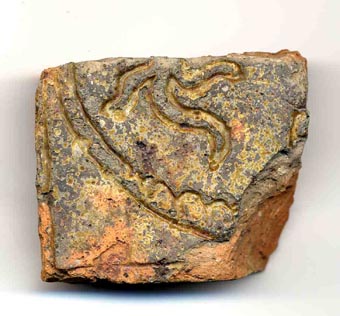
Martin searched the area thoroughly but could find no more evidence. Apparently the spot where he found the tile at the bottom of his garden had been used for many years in the past as a sort of refuse disposal area by his father so the tile may indeed have come from elsewhere. The fragment of tile was identified as a very good example of a medieval floor tile by a local archaeologist. There were similar tiles found at Kildare Cathedral. It is hoped to display the tile in Kildare Town Heritage Centre but also to map the actual location and send measurements and photographs to the National Museum.
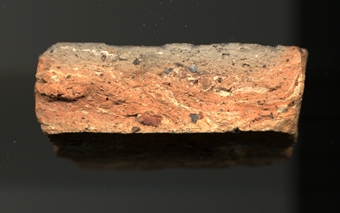 Side views of floor tile fragment
Side views of floor tile fragment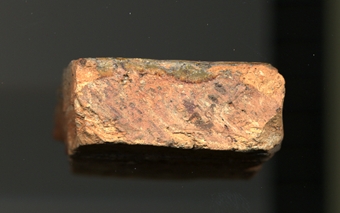
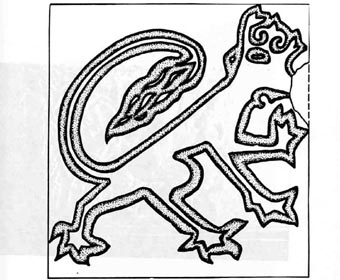 Drawing of floor tile from Kildare Cathedral from the unpublished Urban Archaeological Survey Volume 4 - Bradley, Halpin and King
Drawing of floor tile from Kildare Cathedral from the unpublished Urban Archaeological Survey Volume 4 - Bradley, Halpin and King
Medieval floor tile fragment found at Kildare by Martin Kinsella, member of Cill Dara Historical Society
Posted by mariocorrigan at 11:00 AM
February 11, 2008
ST. BRIGID'S DAY -WALKING TOUR
Fantastic reaction to Walking Tour
The first walking tour of the season was organised by Sr. Mary Minihan of the Brigidine Sisters in association with Kildare Town Walking Tours (Kildare Town Heritage Centre, Kildare Outlet Shopping, Kildare Cathedral, Grey Abbey Conservation Project and Cill Dara Historical Society) for Friday 1st Feb., St. Brigid's Day as part of the Annual Feile Bhride Festival.
Despite truly horrendous conditions including driving snow and rain some 35 hardened individuals (including two classes from local schools) turned out to walk in the footsteps of St. Brigid - Mary of the Gael, the Patroness of Ireland. They were under the guidance of Mario Corrigan, Local Studies Librarian and Chairman of the Kildare Heritage Committee and well-known Co. Kildare historian James Durney. But the walks are not simply about history and heritage they are about conversation, exercise and enjoyment and as they say - the craic was mighty!
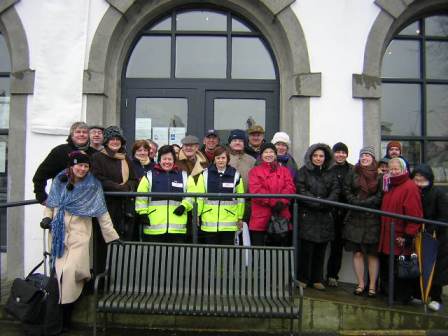 Above: Outside Kildare Heritage Centre the brave few who saw it through 'till the end.
Above: Outside Kildare Heritage Centre the brave few who saw it through 'till the end.
WALKS FOR 2008 - beginning Sunday of St .Patrick's weekend, Easter Sunday and the Sunday May weekend - contact the
Heritage Centre for details.
If we can accomodate you we will arrange a tour when it suits you.
Learn about the mythology of Fionn Mac Cumhaill and St Brigid, patroness of the Gaels. Key stops along the route include St Brigid’s Cathedral, a Norman tower house, the site of the Turf Club, and the twelfth century Franciscan Abbey.
Tour Times:
11 am on Saturdays, 1 pm on Sundays and 11 am on Mondays
1st June – 31st August - OTHER DAYS AVAILABLE ON REQUEST
Departure point is Kildare Town Heritage Centre, Market Square, Kildare. Please assemble at the heritage centre fifteen minutes before the commencement of the tour. The tour begins at 11 am or 1 pm sharp.
Adults €3, Families €6 (2 adults and up to 4 children)
SPECIAL GROUP RATES AVAILABLE
Tickets available from Kildare Town Heritage Centre (045 530672) and Kildare Village Tourist Information Centre (045 520501) or from the guide.
The tour covers approximately 1.8 km (just over 1 mile). Allow 1 hour 30 minutes for full tour including St Brigid’s Cathedral.
Terms and conditions:
- The tour requires a minimum of 2 people to go ahead
- Children must be accompanied by an adult
Posted by mariocorrigan at 11:25 PM
January 22, 2008
FEILE BHRIDE 2008
25/1/2008 - Feile Bride 2008
Féile Bríde - Brigid's Festival is a week long series of events running up to Brigid's Day on the first day of February.
Féile Bríde, incorporates a Peace and Justice conference in collaboration with Afri - Action from Ireland, workshops, and a candle lit ritual on Brigid's Eve at the well.
Friday, January 25th
Drumming workshop
Facilitator: John Bowker
Venue: St. Brigid's Primary School
Time: 7.30 p.m.
Admission: €12.00 Concessions €8.00
Early Booking essential: 045 521575
All ages welcome
Saturday, January 26th
Afri Conference - "Seeing the World in a Different Way"
Afri Justice and Peace Conference will focus on the issues of the arms race. Is there an alternative way?
Venue: Derby House Hotel
Time: Gathering at the Flame in the Market Sq. Kildare at 1:00 p.m.
Registration / Tea and coffee at 1:30 p.m. Conference:2.00 p.m. - 6.00 p.m.
Admission: €25 Concessions €20
Booking by January 22nd.
Book by phoning AFRI on:
Tel: 01-8827581
Fax: 01-8827576
AFRI website: http://www.afri.ie/
email: afri@iol.ie or www.afri.ie
Seisiun
Ceol, rince, agus craic.
Venue: Derby House Hotel
Time: 8.30 p.m.
Admission: €5.00
Sunday, January 27th
Eucharistic Celebration at St.Brigid's Well
Time: 10.00 a.m.
11.15 a.m. Tea/ Coffee / Aras Bhride
Time: 11.15 a.m.
Venue: Aras Bhríde
Workshop - The Cosmic story in poetry, song and dance
Venue: Aras Bhríde
Time: 11.45a.m. - 1.15p.m.
Admission: €10
Monday, January 28th
Afri "Education for Liberation" Day.
A day for schools in Midland Region.
Venue: Derby House Hotel
Contact: Clare, 045 883591
Tuesday, January 29th
The Annual Celtic Lecture
Hosted by Kildare Education Centre
"Brigid through the Ages"
Prof. Mairin Ni Dhonnachadha, NUI, Galway
Booking through the Education Centre at 045 530200
Venue: Kildare Education Centre
Time: 8.p.m.
Admission: €10.00
Wednesday, January 30th
-
A Night of Music
A Night of music with members of Kila, Celtic Shadows and Friends
Venue: Derby House Hotel
Time: 8.00 p.m.
Admission: €20.00
Thursday, January 31st
Brigid's Eve Ritual at St. Brigid's Well
Assemble at 7.20 p.m. at Japanese Gardens' car park.
Friday, February 1st
La Fheile Bhride – Imbolc - St. Brigid's Day
Visitors to the town will have the opportunity to experience hospitality and learn the craft of weaving Brigid crosses at Aras Bhride and Kildare Heritage Centre.
Venues: Aras Bhride (Parish Centre) & Kildare Heritage Centre.
Kildare - Monastic City
A gentle walk around the ancient monastic city of Kildare with Mario Corrigan
Assemble in the Market Square, at St. Brigid's Flame.
Time: 1.30 p.m.
Saturday, February 2nd
Youth Pilgrimage Day
Time: 2.30
Venue: Assemble at St. Brigid's Parish Church
Posted by mariocorrigan at 01:14 PM
August 29, 2007
Cill Dara Historical Society Talk - Hill of Allen by Sean Byrne
Cill Dara Historical Society
Kildare Town's Local History Group
presents
The Hill of Allen
with
Sean Byrne
Wednesday 5th September
8 p.m. Kildare Education Centre (Old Parochial House)
Friary Road, Kildare Town
Sean Byrne having delivered an excellent talk in 2006 on Kilmeague, returns to Kildare Town with a talk on the Hill of Allen which is being hosted by Cill Dara Historical Society, Wed. 5th Sept. 2007
Posted by mariocorrigan at 10:47 AM
August 24, 2007
UNVEILING OF GREY ABBEY MONUMENT 22 AUG 2007
New Monument at Grey Abbey
At the Annual Graveyard Mass at Grey Abbey on Wednesday night, 7.30 p.m., 22 August 2007 a monument was unveiled to all those buried without record at Grey Abbey. Mass was consecrated by Parish Priest Fr. Adrian Carbery and Fr. Loughlin Flanagan. Fr. Carbery invited Fr. Flanagan to lay a wreath at the monument to commemorate all those who were buried in the graveyard but whose graves lie unmarked or unrecorded.
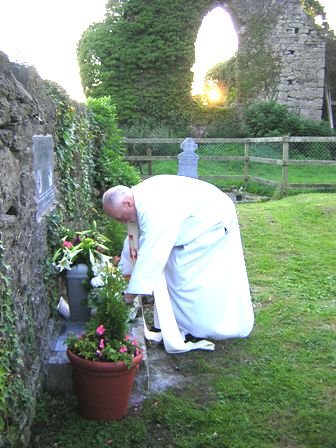
The monument was erected by the Grey Abbey Conservation Project and paid for from the proceeds of the ‘Church of the Oak’ book which was published late in 2006. It is hoped that the monument will provide a place for people to say a prayer or lay a wreath or flower in memory of their loved ones as so many people were buried there but it is impossible to locate the exact location of all the graves.
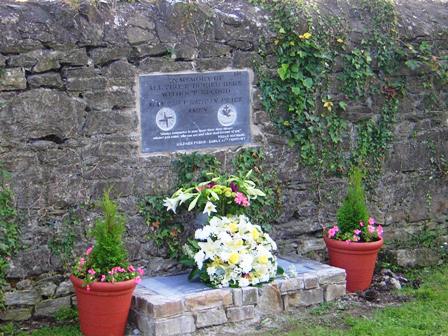
The beautiful monument was sculpted by local stone mason Sean Daly. It simply states
IN MEMORY OF
ALL THOSE BURIED HERE WITHOUT RECORD
MAY THEY REST IN PEACE
AMEN.
Always remember in your heart those three things:
whence you come, who you are and what shall become of you.
Friar Michael of Kildare
Kildare Poems – Early 14th Century
ERECTED BY THE GREY ABBEY CONSERVATION PROJECT 2007
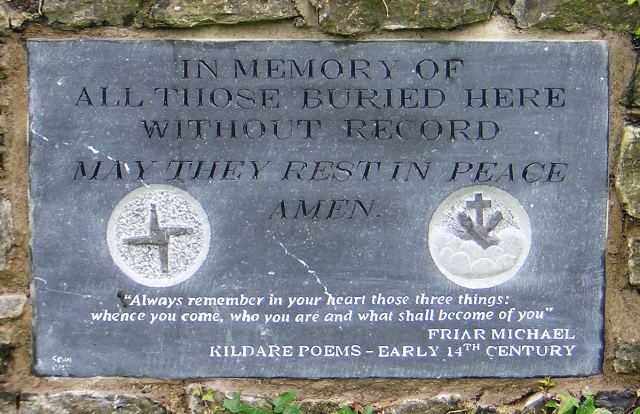
There are two crests - one a St. Brigid’s Cross representing the Parish of Kildare and the second, the Franciscan crest, as Grey Abbey was a Franciscan foundation. The latter crest was graciously supplied at extremely short notice by Fr. Ignatius Fennessy of the Franciscan Order, at their Library in Killiney - our sincerest thanks.
The wreath was supplied by Violets flowers shop and the plants each side were supplied by Guilfoyles Garden Centre - a truly local venture which was important to the Project from the outset. The Project is also grateful tothe Environment Section and National Monuments Advisory Committee of Kildare County Council who gave permission for, and advice on the erection of the monument.
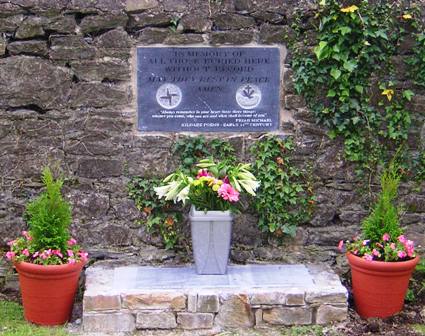
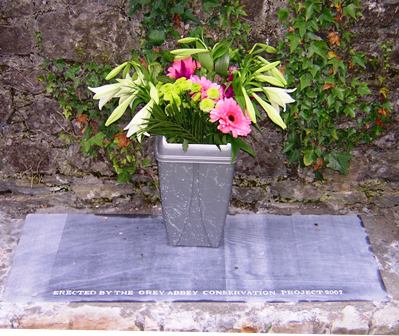
The Council have also granted permission to have the gates restored and re-hung and it is hoped this will be accomplished in the next few weeks; once again this will be paid out of the proceeds of the book which also allowed the Project to purchase a new strimmer and lawn mower in 2007. Special tribute must be made to Paddy and Frank who look after the graveyard and had it looking absolutely beautiful for the mass. We would also like to thank Christy who was involved in this work until recently.
To all those who have helped along the way, especially Joe Connelly and the Cill Dara Historical Society, to all those who bought the book and the people of Kildare Town generally who have supported us throughout - THANK YOU.
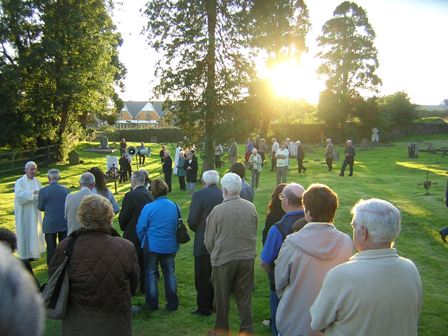
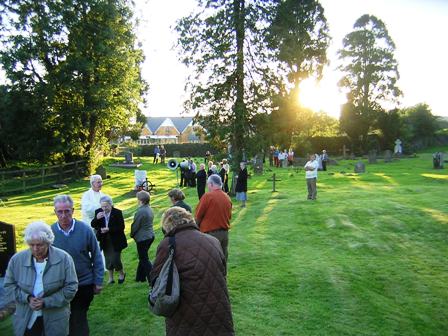
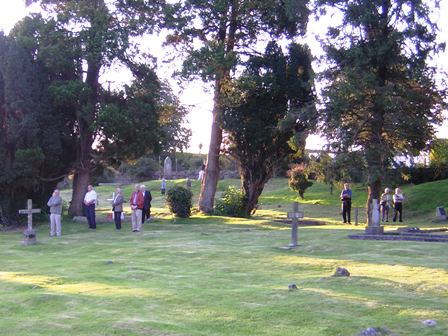
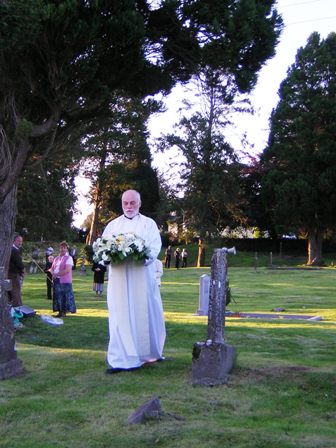
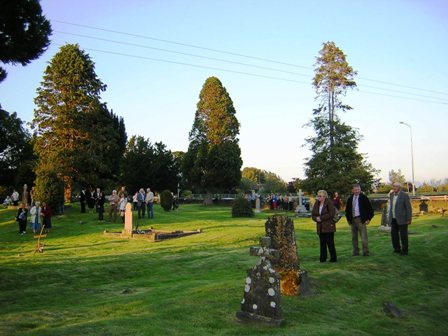
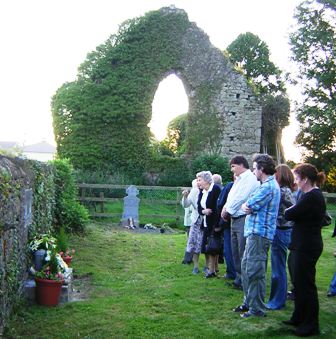
Posted by mariocorrigan at 01:44 PM
May 26, 2007
Rare Books Fair, Craft Fair and Car Rally 3 June 07 Kildare Town
Local Studies, Genealogy and Archives
Kildare
County Library and Arts Service
in association with
Lyonshill Books & Cill Dara Old Vehicles Club
presents
THE 2007
COUNTY
KILDARE
RARE BOOKS FAIR
AND
GORDON BENNETT IRISH CLASSIC CAR RUN
KILDARE
TOWN 1 p.m. – 5 p.m.
SUNDAY 3 JUNE 2007
All welcome - No cover charge
RARE BOOKS FAIR -
KILDARE
TOWN HERITAGE CENTRE and
KILDARE
TOWN PARISH CENTRE
CRAFT FAIR - BOLAND’S YARD.
CLASSIC CAR RUN -
THOUSANDS AND THOUSANDS OF BOOKS, RARE, ANTIQUARIAN AND LOTS OF BARGAINS And FREE VALUATIONS !!!
History, local, national, literature, poetry, sport, fiction and ephemera.
Why not take the opportunity to visit
Kildare
Town – ST. BRIGID’S CATHEDRAL, THE
JAPANESE
GARDENS , KILDARE HERITAGE CENTRE and the fantastic
KILDARE
OUTLET
VILLAGE .
More info:- Mario Corrigan PH 087-9871046 (Tues to Sat) – Email:- localhistory@kildarecoco.ie
Eddie Murphy PH 087-2567908 Email:-lyonshillbooks@eircom.net
Details of the 2nd County Kildare Rare Books Fair Sun 3 June Kildare Town - also a Craft Fair and the Gordon Bennett Commemorative Rally - all free - all on the same day.
Posted by mariocorrigan at 02:47 PM
Cill Dara Historical Society Annual Outing 2007
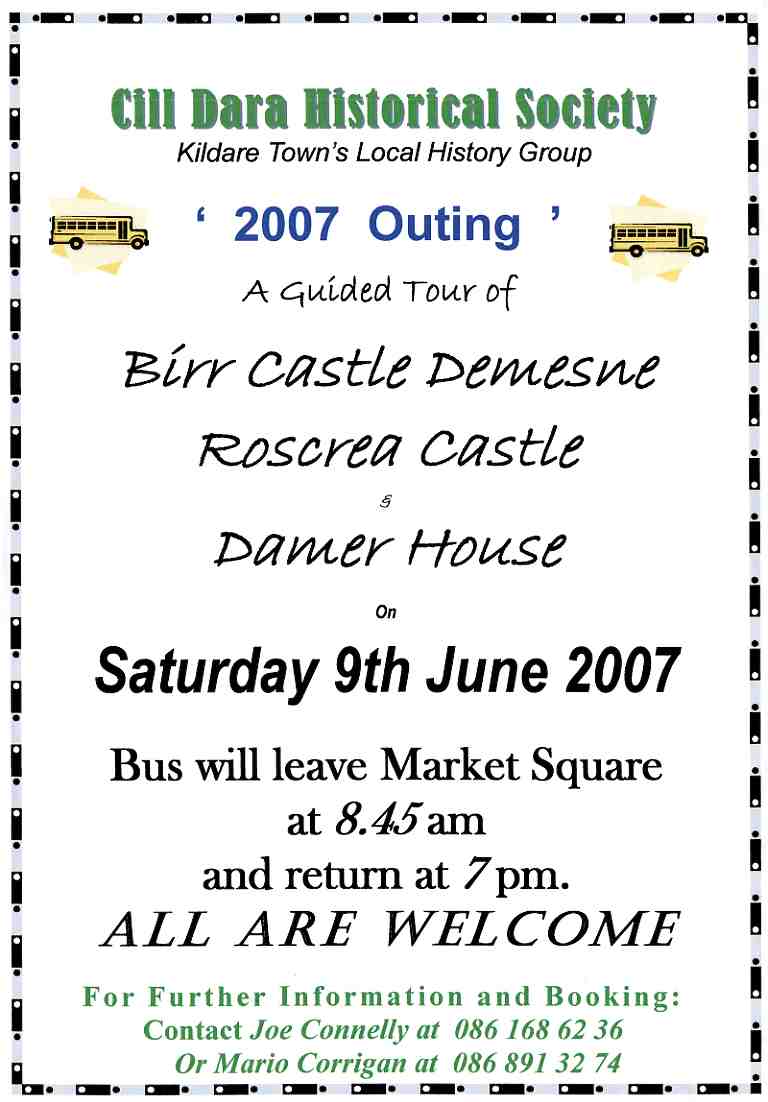
Details of the Cill Dara Historical Society Outing for Sat. 9 June 2007 to Birr and Roscrea - anybody interested should contact us straight away. If it is anything like last years then expect a great day out.
Posted by mariocorrigan at 01:54 PM
May 15, 2007
Federation Annual Seminar
Kildare Federation of Local History Groups Annual Seminar
Historians from Carbury to Castledermot and everywhere in between will gather in Kilcullen on Saturday 26 May for the annual seminar of the Kildare Federation of Local History Groups.
With over a dozen affiliated groups throughout Kildare the Federation gives locals involved in the history movement a chance to share discoveries and knowledge. The programme begins at 10am in the Kilcullen Heritage Centre where an array of Co. Kildare topics will be presented followed by an open forum. In the afternoon the participants will travel to Clongowes Wood College for a guided tour of the hallowed college and its castle orgins. This is the eight annual seminar run by the Federation and the event will be opened by Mayor of Kildare, Cllr. Fionnuala Dukes.
Topics to be covered on the morning include the fascinating story of the Lock Hospital in Kildare by award winning historian Hugh Crawford; the old Naas Gaol by Brian Crowley and the story of Thomas Wentworth who commissioned Jigginstown Castle by writer and broadcaster Mae Leonard.
For more information and registration contact Federation Secretary Larry Breen on 045 897445.
A note from Liam Kenny on the forthcoming Kildare Fedaration of Local History Groups Annual Seminar an ideal opportunity for people to meet, learn and discuss the heritage and history of Kildare
Posted by mariocorrigan at 10:32 AM
Federation Annual Seminar
Kildare Federation of Local History Groups Annual Seminar
Historians from Carbury to Castledermot and everywhere in between will gather in Kilcullen on Saturday 26 May for the annual seminar of the Kildare Federation of Local History Groups.
With over a dozen affiliated groups throughout Kildare the Federation gives locals involved in the history movement a chance to share discoveries and knowledge. The programme begins at 10am in the Kilcullen Heritage Centre where an array of Co. Kildare topics will be presented followed by an open forum. In the afternoon the participants will travel to Clongowes Wood College for a guided tour of the hallowed college and its castle orgins. This is the eight annual seminar run by the Federation and the event will be opened by Mayor of Kildare, Cllr. Fionnuala Dukes.
Topics to be covered on the morning include the fascinating story of the Lock Hospital in Kildare by award winning historian Hugh Crawford; the old Naas Gaol by Brian Crowley and the story of Thomas Wentworth who commissioned Jigginstown Castle by writer and broadcaster Mae Leonard.
For more information and registration contact Federation Secretary Larry Breen on 045 897445.
A note from Liam Kenny on the forthcoming Kildare Fedaration of Local History Groups Annual Seminar an ideal opportunity for people to meet, learn and discuss the heritage and history of Kildare
Posted by mariocorrigan at 10:32 AM
December 12, 2006
CHURCH OF THE OAK ON SALE
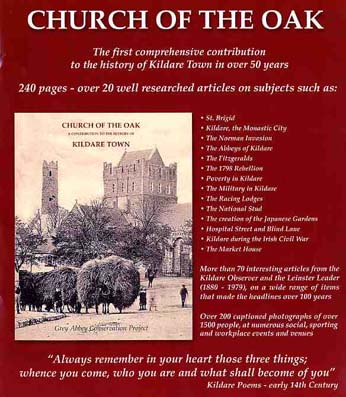
THE IDEAL CHRISTMAS PRESENT
for your friends and relatives from Kildare Town, particularly those overseas.
CHURCH OF THE OAK
The first comprehensive contribution to the history of Kildare Town in over 50 years
PUBLISHED BY THE GREY ABBEY CONSERVATION PROJECT
All proceeds to The Grey Abbey Conservation Project
ON SALE
AT
Malone's Newsagents, The Railway Stores, Dunmurray Stores, Kildare Town Heritage Centre, Kildare Parish Centre (Aras Bhride), Connollys Pharmacy, Centra (Maryville), Southwells etc.
and Cards and Things (Porters) in Newbridge
240 Pages – over 20 well researched articles on subjects such as
St. Brigid
Kildare, the Monastic City
The Norman Invasion
The Abbeys of Kildare
The Fitzgeralds
The 1798 Rebellion and the Gibbet Rath Massacre
Poverty in Kildare
The military in Kildare
The Coffee House and the Racing Lodges
The National Stud – the first 50 years
The creation of the Japanese Gardens
Recollections of Hospital Street and Blind Lane
Kildare during the Irish Civil War – 1922
The Market House – Kildare Town Heritage Centre
More than 70 interesting articles from the Kildare Observer and the Leinster Leader from 1880 – 1979 – a wide range of items that made the headlines over 100 years
Over 200 captioned photographs of over 1500 people, at numerous social, sporting and workplace events and venues
Posted by mariocorrigan at 09:19 PM
CIVIL WAR COMMEMORATION
December Civil War Commemoration
The National Graves Association recently renovated the Republican Plot in Grey Abbey Cemetery, Kildare Town, County Kildare. The Plot contains the remains of Seven Volunteers executed by the Free State on the 19th December 1922. They were Vol: Patrick Bagnel Vol: Joseph Johnson Vol: Patrick Nolan : Vol: Patrick Mangan Vol: Brian Moore Vol: Joseph O Connor and Vol: Stephen White.
The association will hold a commemoration on
Saturday 16th December 2006 at 12 p.m. (mid-day),
assembling at
Grey Abbey Cemetery, Kildare Town, County Kildare.
For more details please contact 087 2282033.
* This Project was initiated by the Grey Abbey Conservation Project and fully funded by the National Graves Association. The National Graves Association also provided some funding for the restoration of the Civil War Monument on the Market Square in Kildare Town in association with the Kildare Tidy Towns Committee. Our appreciation to both these organisations.
Details of the restoration and pictures of the Monument before and after the restoration can be viewed on this website.
Posted by mariocorrigan at 09:06 PM
CIVIL WAR MEMORIAL, MARKET SQUARE, KILDARE TOWN
Irish Civil War Memorial at Market Square, Kildare
Stephen Talbot
In December of 1922 during the course of the Irish Civil War, seven young men from Kildare were executed. They were: Patrick Bagnall (19), Stephen White (19), Jackie Johnston (18), Patrick Nolan (24), Patrick Mangan (22), James Connor (24), Brian Moore (37). The white marble memorial at Market Square, Kildare was erected in 1935 by a local committee and surrounded by iron railings and bears the inscription:
“May God diffuse their spirit among us”
This railing fell into disrepair some years ago and efforts to have it repaired or replaced have been ongoing. Recent contact was made with the National Graves Association, who are responsible for the upkeep of such memorials and they very kindly gave, not only their support for the replacement of the railing but also a financial contribution towards the project. The project, spearheaded by Kildare Tidy Towns Committee was undertaken in May 2006 and the shamrocks, which were a feature of the old railing, were transplanted onto a new one.
The new railing which is galvanised, was installed on Friday 30th June 2006.
Restoration of Memorial and replacement of railings.
Posted by mariocorrigan at 09:05 PM
November 27, 2006
CHURCH OF THE OAK - Book Launch
CHURCH OF THE OAK
BOOK LAUNCH
The Grey Abbey Conservation project launched their book, 'Church of the Oak; a contribution to the history of Kildare Town,' in Aras Bhride, the Kildare Town Parish Centre on Friday 24th November, at .8 p.m.
The book was launched by the Mayor of Kildare, Councillor Fionnuala Dukes and is the first comprehensive contribution to the history of Kildare Town in over 50 years.
Compiled and edited by Mario Corrigan and Ger Kelly it is published by The Grey Abbey Conservation Project.
As well as the excellent 'Short History of Kildare Town,' by Mark McLoughlin, the book contains over 20 well researched articles on subjects such as
St. Brigid
Kildare, the Monastic City
The Norman Invasion
The Abbeys of Kildare
The Fitzgeralds
The 1798 Rebellion and the Gibbet Rath Massacre
Poverty in Kildare
The Military in Kildare
The Coffee House and the Racing Lodges
The National Stud – the first 50 years
The creation of the Japanese Gardens
Recollections of Hospital Street and Blind Lane
Kildare during the Irish Civil War – 1922
The Market House – Kildare Town Heritage Centre
There are more than 70 interesting articles from the Kildare Observer and the Leinster Leader from 1880 – 1979 – a wide range of items that made the headlines over 100 years with over 200 captioned photographs of over 1500 people, at numerous social, sporting and workplace events and venues
All proceeds will go to The Grey Abbey Conservation Project.
There was a large turnout on the night and the book was very well received by all who attended.
The Grey Abbey Conservation Project would like to thank all those who made it possible, the contributors and those who who generously donated their photographs. We are extremely grateful for the generous support of KELT without which the book could never have been published and indeed the financial support of the people of Kildare Town at the annual Church Gate Collection.
We would also like to acknowledge the continued support of FAS and the CE scheme and Kildare County Council.
To mark the launch I will add some of the articles from CHURCH OF THE OAK to the site.
The Grey Abbey Conservation Project have launched their contribution to the history of Kildare Town, entitled CHURCH OF THE OAK
Posted by mariocorrigan at 09:30 PM
November 14, 2006
COUNTY KILDARE RARE BOOKS FAIR
Local Studies, Genealogy and Archives, Kildare County Library and Arts Service,
in association with
Lyonshill Books, presents
THE FIRST EVER CO. KILDARE
RARE BOOKS FAIR
KILDARE TOWN 1 p.m. – 5 p.m.
SUNDAY 19 NOVEMBER 2006
ALL WELCOME - NO COVER CHARGE - 3 VENUES
KILDARE TOWN HERITAGE CENTRE; KILDARE TOWN PARISH CENTRE AND THE FOYER OF EUROSPAR
THOUSANDS AND THOUSANDS OF BOOKS, RARE, ANTIQUARIAN AND LOTS OF BARGAINS And FREE VALUATIONS !!!
History, local, national, literature, poetry, sport, fiction and ephemera.
Why not take the opportunity to visit Kildare Town – ST. BRIGID’S CATHEDRAL, THE JAPANESE GARDENS, KILDARE HERITAGE CENTRE and the fantastic new
KILDARE OUTLET VILLAGE.
The three venues are
Foyer of Eurospar - on main street (Claregate Street) - has underground parking
Heritage Centre- Market House Market Square - parking on the Market Square and also Nugent Street (north of Market Square towards the Railway Station) beside the playground - pedestrian access back to Market Square
Parish Centre or ARAS BHRIDE - beside RC Church on St. Brigid's Square - parking on St. Brigid's Square
Also Parking in Kildare Outlet Village - easily accessed from motorway - pedestrian access to Kildare Town across boardwalk at Grey Abbey (Franciscan ruin) straight to St. Brigid's Square
There will be a map at each venue and sandwich boards outside each venue to direct people.
M7 from Portlaoise direction - slip road to Kildare - left at roundabout - right at next roundabout to Kildare Outlet Village or straight through to lights - turn right straight through to Kildare Town Centre - Eurospar on left and Marhet House/Heritage Centre on Square
M7 from Dublin - slip road to Kildare at end of Curragh (not Newbridge exit) 2 ways - (1) left at roundabout and immediate left again to St. Brigid's Square - Parish Centre; (2) right at roundabout and across the bridge then straight through next roundabout to Kildare Outlet Village or straight through to lights - turn right straight through to Kildare Town Centre - Eurospar on left and Market House/Heritage Centre on Square
From Athy - Booleigh Cross - Nurney - Newtown Cross and Old Nurney Road - 2 ways - (1) right to St. Brigid's Square - Parish Centre; (2) straight through at 1st roundabout and across the bridge then straight through next roundabout to Kildare Outlet Village or straight through to lights - turn right straight through to Kildare Town Centre - Eurospar on left and Market House/Heritage Centre on Square
Details and directions to County Kildare Rare Books Fair, Sunday 19th November, Kildare Town.
Posted by mariocorrigan at 02:27 PM
November 08, 2006
CIVIL WAR MONUMENT CLEANED UP
The Civil War Monument erected by the National Graves Association in 1940 at Grey Abbey has been beautifully restored to its former glory. The surrounds have also been cleaned and chippings added to the grave to complete the restoration. The work was finished last week by Annette Emerson from Laois. She was engaged by Matt Doyle of the National Graves Association after being contacted by the Grey Abbey Conservation Project regarding the condition of the grave earlier this year. The National Graves Association paid for the restoration of the monument and the cleanup of the grave and earlier this year co-funded, with Kildare Tidy Towns, the restoration of the railings around the civil war monument on the Market Square. They hope to have a small ceremony in December 2006 in Kildare Town in honour of the men executed in 1922 and to mark the work done this year.
The Grey Abbey Conservation Project would like to gratefully thank them for their efforts and their commitment to their work, not just in Kildare but throughout the country.
The monument was erected to commemorate the seven I.R.A. Volunteers executed at the Curragh on the 18 December 1922. Their bodies were initially buried at the Curragh but they were re-interred in Grey Abbey in 1924. A moument was erected on the Market Square in 1935 and another at Grey Abbey in 1940 to mark the grave.
Photos from 12 April 2004
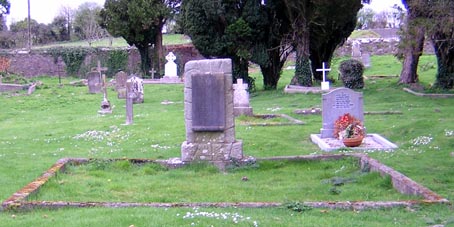
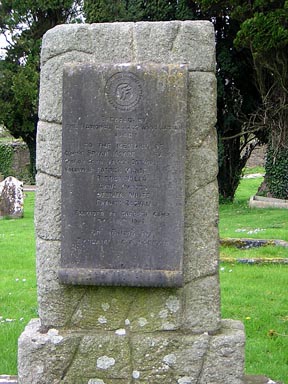
Photos from Monday 6 November 2006
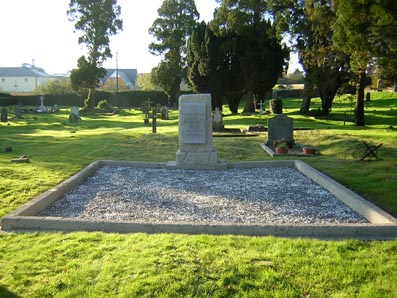
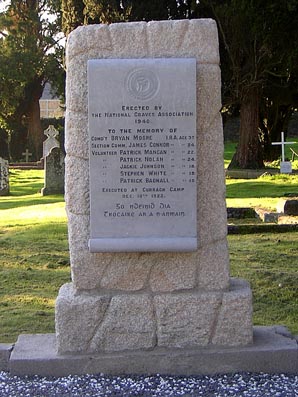
The Civil War Monument at Grey Abbey has been restored by the National Graves Association
Posted by mariocorrigan at 12:28 AM
November 03, 2006
County Kildare Rare Books Fair Sunday 19/11/2006
Local Studies, Genealogy and Archives
Kildare County Library and Arts Service
in association with
Lyonshill Books
presents
THE FIRST EVER CO. KILDARE
RARE BOOKS FAIR
KILDARE TOWN
1 p.m. – 5 p.m.
SUNDAY 19 NOVEMBER 2006
All welcome
No cover charge
KILDARE TOWN HERITAGE CENTRE; KILDARE TOWN PARISH CENTRE AND THE FOYER OF EUROSPAR
Please support this event so we might ultimately make it an Annual Local History and Heritage Event!
THOUSANDS AND THOUSANDS OF BOOKS, RARE ,ANTIQUARIAN AND LOTS OF BARGAINS And FREE VALUATIONS !!!
History, local, national, literature, poetry, sport, fiction and ephemera.
Why not take the opportunity to visit Kildare Town – ST. BRIGID’S CATHEDRAL, THE JAPANESE GARDENS, KILDARE HERITAGE CENTRE and the fantastic new
KILDARE OUTLET VILLAGE.
MAKE AN AFTERNOON OF IT!
More info:- Mario Corrigan PH 087-9871046 (Tues to Sat) – Email:- localhistory@kildarecoco.ie
Eddie Murphy PH 087-2567908 Email:-lyonshillbooks@eircom.net
AN HISTORIC FIRST!
The first ever County Kildare Book Fair will take place on Sunday afternoon on the 19 November in Kildare Town. This will be an opportunity for those interested in Local History and heritage as well as the general population who are interested in books and reading in general to visit a Rare Books Fair outside of Dublin. It is being organised by the Local Studies, Genealogy and Archives Department of Kildare County Library and Arts Service in conjunction with Kildare County Council and Lyonshill Books. According to Local Studies Librarian, Mario Corrigan, "there is an enormous interest in Dublin and other areas in this sort of event and it is about time we in County Kildare had the opportunity to have one locally. It is an ideal opportunity also for anyone who has not yet visited the new Kildare Retail Outlet Village to come to the town and see what is on offer."
The event is free and open to all and will allow people to browse the books on offer in the three different venues - The kildare Heritage Centre, The Kildare Parish Centre and the foyer of the Eurospar Shopping Centre. "The idea behind the three venues is to encourage people to walk through Kildare Town and thoroughly enjoy the day," said Mario Corrigan who has recently published a Sli na Slainte and Heritage Trail of Kildare Town and is anxious that people enjoy the experience that Kildare, the Heritage Town, has to offer.
Eddie Murphy of Lyonshill Books is delighted to be able to add County Kildare to a growing list of Book Fairs that he and his colleagues have orchestrated. "It is an immensely pleasurable experience, whereby people can browse the stalls and hopefully with this new initiative in Kildare Town take in some of the rich heritage of such an historic setting - maybe pause in the local shops or the local cafes and pubs for a coffee and even visit the Outlet Village for a unique shopping experience. We do hope this proves to be successful and we can turn it into an annual event," said Mr. Murphy.
So why not take an afternoon break on Sunday 19 November and come to Kildare Town to the County's first Rare Books Fair - maybe in search of a unique Christmas gift or just to amble through the historic streets and enjoy the experience. Currently there is an exhibition of Kildare artists, a collaboration between the Outlet Village and Riverbank Arts Centre, on view in the Kildare Outlet Village and Kildare Town Heritage Centre has a host of collectibles and gift ideas to wet you appetite.
As well as book dealers The Kildare Archaeological Society, Kildare Federation of Local History Groups, the Grey Abbey Conservation project and Cill Dara Historical Society will hopefully have information on their organisations and activities on display for people to view. All in all it is an ideal day out and most importantly - it's free.
The first County Kildare Rare Books Fair will take place on Sunday 19 November.
Posted by mariocorrigan at 09:54 PM
August 16, 2006
THE GREAT HOUSE IN COUNTY KILDARE-HISTORICAL PERSPECTIVE AND CONTEMPORARY ROLE
County Kildare Archaeological Society
"The Great House in County Kildare: historical perspective and
contemporary role"
An illustrated talk presented by Michael Dempsey and Glascott Symes in celebration of National Heritage Week.
Wednesday 6th September at 7.30p.m. Riverbank Arts Centre, Newbridge by courtesy of Kildare County Council.
Free of charge-all welcome!
This is the 2nd seminar organised by the County Kildare Archaeological Society and the Local Studies Dept. of Kildare County Library and Arts Service.
Details of a talk by Michael Dempsey and Glascott Symes to be given to mark National Heritage Week.
With regards to Heritage week 2006, have a look at the Heritage Council website www.heritageweek.ie where the full listing is searchable by county.
An illustrated talk presented by Michael Dempsey and Glascott Symes in celebration of National Heritage Week will take place on Wednesday 6th September at 7.30p.m. Riverbank Arts Centre, Newbridge in associaltion with the Local Studies Dept., Kildare Co. Library and Arts Service. All are welcome and it is free of charge.
Posted by mariocorrigan at 12:42 PM
June 01, 2006
GRAVEYARD SEMINAR - 15 JUNE 2006 KEADEEN HOTEL
THE CARE & CONSERVATION OF
HISTORIC GRAVEYARDS
Caring for God’s Acre
Keadeen Hotel, Newbridge,
Thursday 15th June 2006
The aims of this seminar are to provide the participants with a knowledge of the main provisions of legislation, policy and procedure relating to the graveyards and to offer advice to those caring for or maintaining graveyards. There is no charge for this seminar but places are limited so booking is essential.
To book please complete this booking form (available through Bridget Loughlin) and return by Thursday 8th June to:
Bridget Loughlin
Heritage Of. cer, Kildare County Council, Áras Chill Dara,
Devoy Park, Naas, Co Kildare.
This seminar also hopes to promote best practice in the management of natural, built and cultural heritage in historic graveyards and to raise awareness of the diverse heritage contained in these graveyards. This is an action of the County Kildare Heritage Plan 2005-2009
THE CARE & CONSERVATION OF HISTORIC GRAVEYARDS
9.30-10.10 Registration
10.00-10.10 Welcome by Ger Smith, Chairman of County
Kildare Heritage Forum
10.10-10.40 "Graveyard Management Legislative
Framework & Archaeological Considerations"
Victor Buckley, National Monuments Section,
Dept of Environment, Heritage & Local Government
10.40-11.10 "Graveyards Full of life" -Ecology of Graveyards
Eanna Ni Lamhna, Freelance Botanist & Journalist
11.10-11.40 Tea/Coffee
11.40-12.10 "Conservation of Architectural & Ecclesiastical Ruins"
JohnCronin & Associates
12.10-12.40 "Symbols of Death- Recording Graveyard Memorials" -
Offaly Graveyard Recording Project
Amanda Pedlow, Offaly Heritage Officer
12.40-1.00 Open forum – Questions and Answers,
Chaired by Cllr. Seamus Moore
This free seminar is sponsored by Kildare County Council &
The Heritage Council.
A seminar on the care and conservation of graveyards will be held on the 15 June 2006 in the Keadeen Hotel. It is organised by the Co. Kildare Heritage Officer, Bridget Loughlin, and is an action of the County Kildare Heritage Plan. The event is sponsored by Kildare Co. Council and the Heritage Council.
Posted by mariocorrigan at 09:47 AM
February 02, 2006
THE LIGHTING OF ST. BRIGID'S FLAME, 1st FEBRUARY 2006
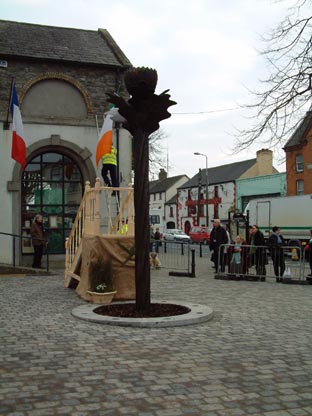
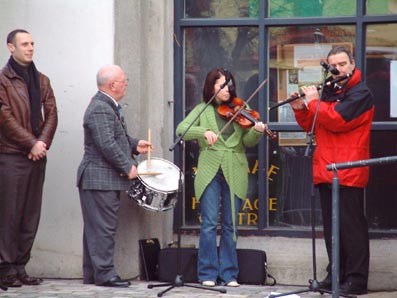
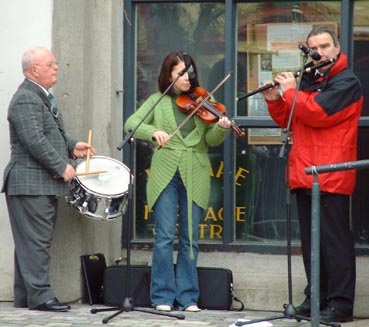
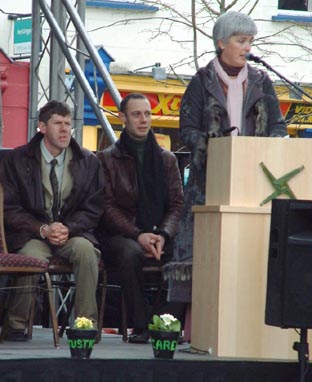
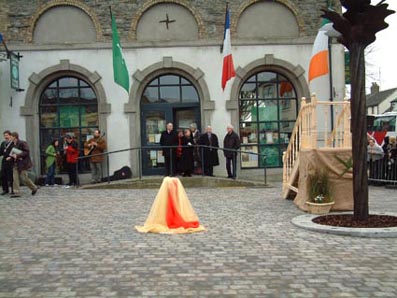
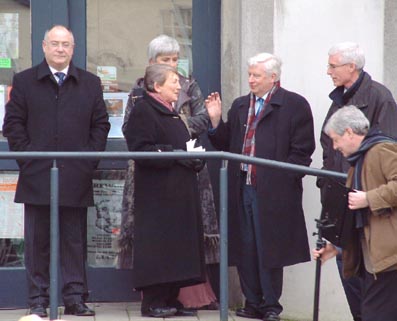
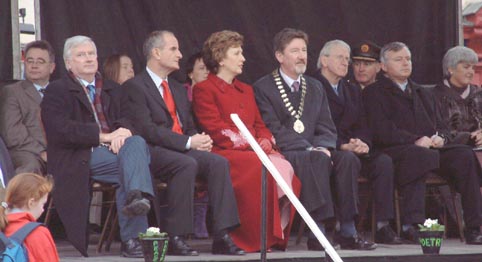
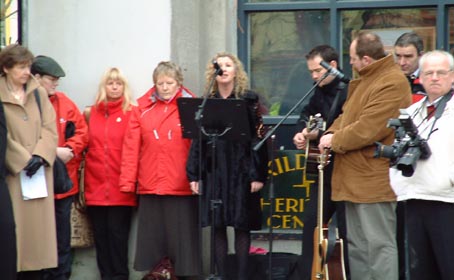
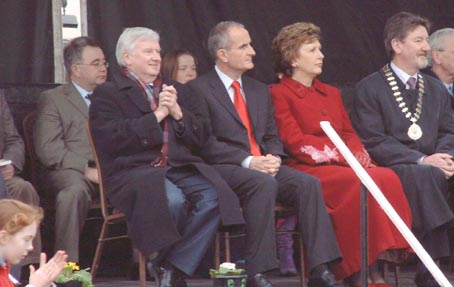
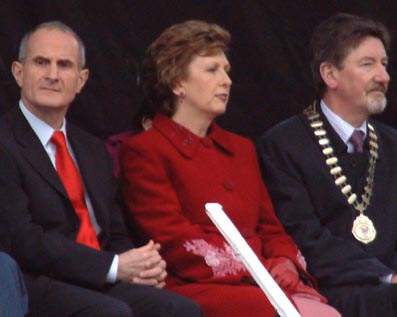
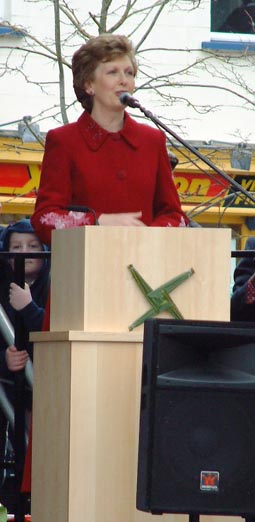
Posted by mariocorrigan at 10:00 PM
February 01, 2006
THE LIGHTING OF ST. BRIGID'S FLAME, 1st FEBRUARY 2006
Re-kindling the Flame
St. Brigid's Day, 1st Feb. 2006
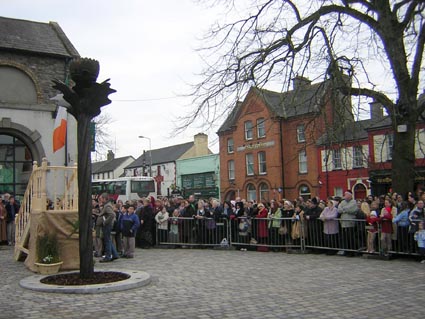
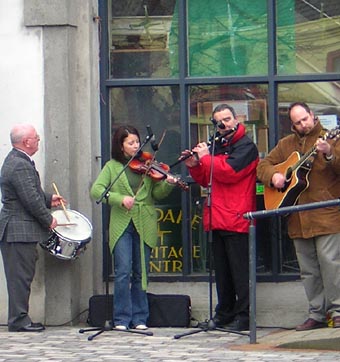
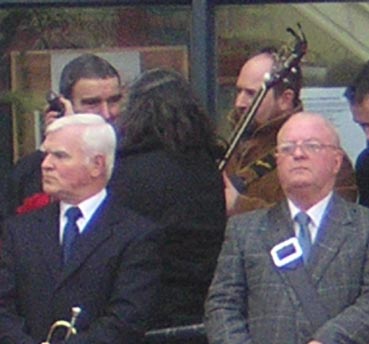
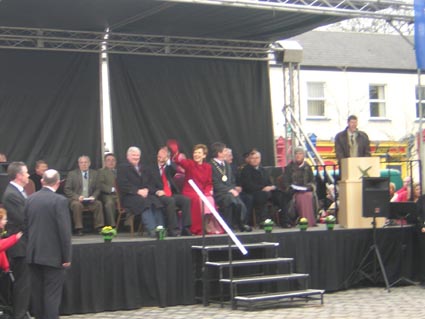
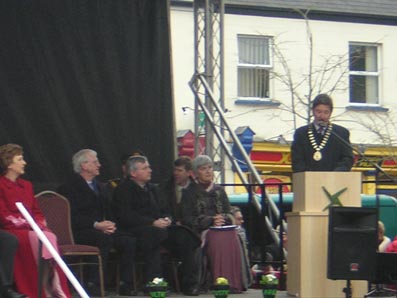
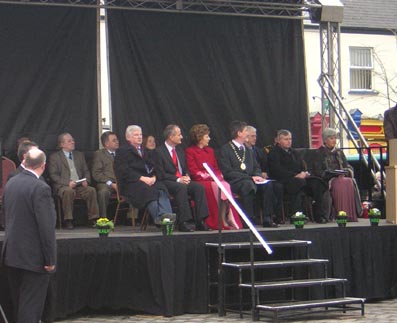
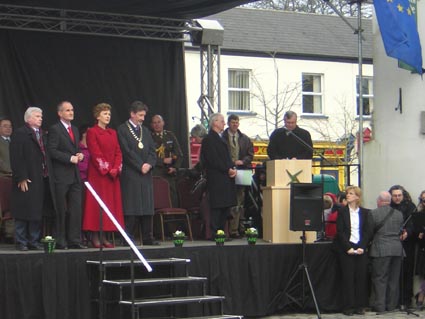
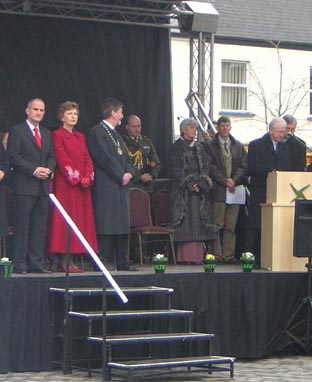
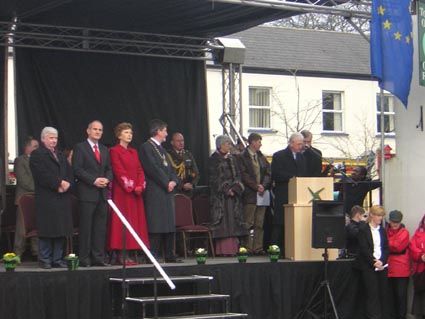
Today, St. Brigid's Day, 1st February 2006, President Mary McAleese, visited Kildare Town to officiate at the re-lighting of St. Brigid's Flame on the Market Square. The beautiful scuplture forms a permanent addition to the newly refurbished Market Square in Kildare and commemorates the historic flame kept alight for centuries by the Brigidine nuns after St. Brigid's death. A huge crowd of onlookers watched as the flame was re-lit and the memory of Brigid, 'Mary of the Gael,' was commemorated once more.
Posted by mariocorrigan at 06:39 PM
THE LIGHTING OF ST. BRIGID'S FLAME, 1st FEBRUARY 2006
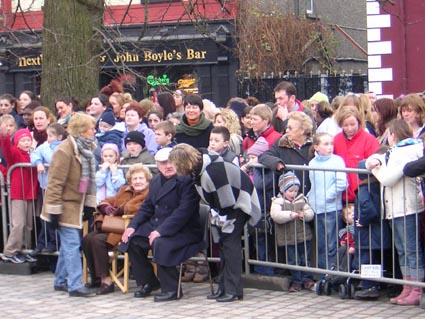
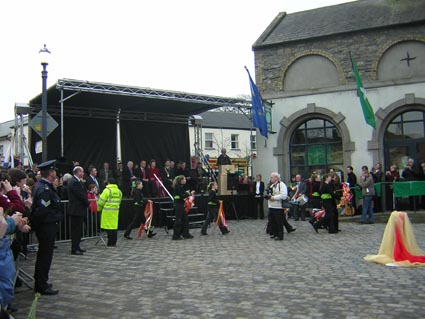
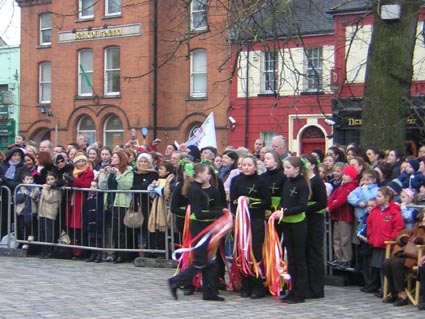
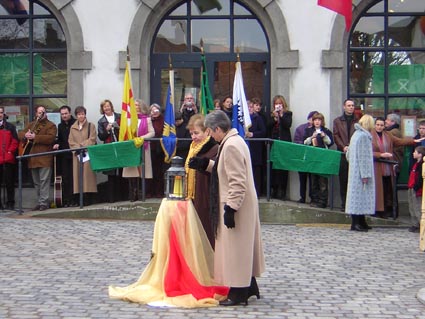
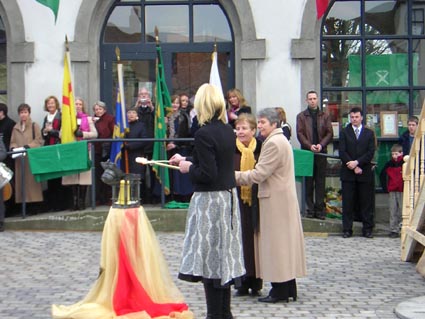
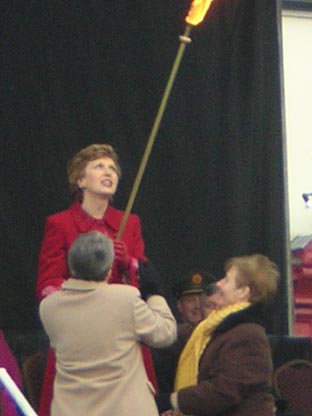
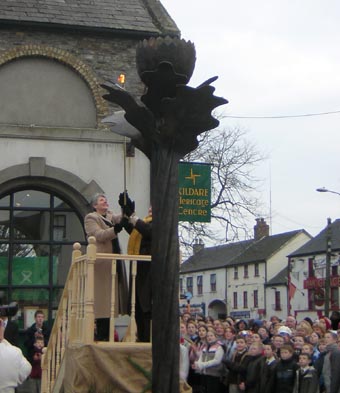
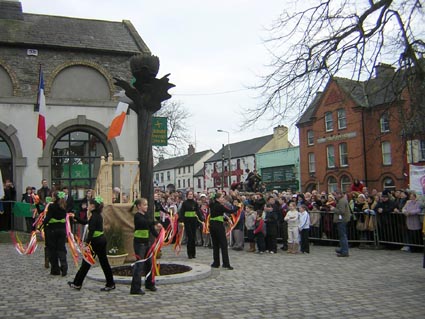
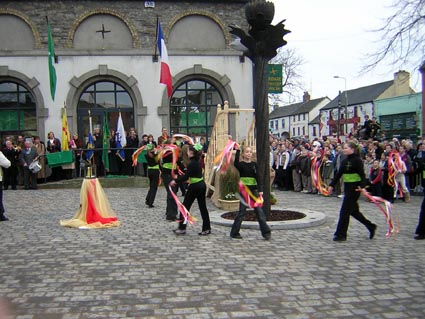
Posted by mariocorrigan at 06:39 PM
THE LIGHTING OF ST. BRIGID'S FLAME, 1st FEBRUARY 2006
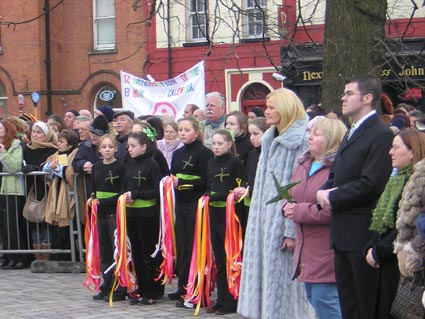
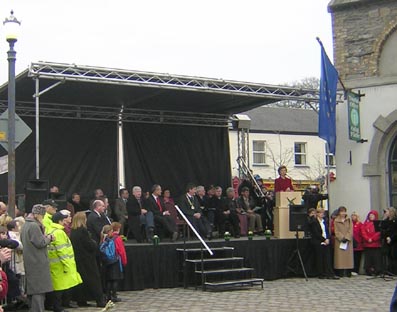
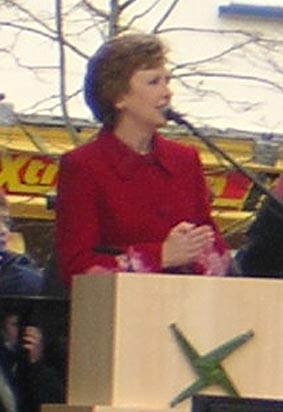
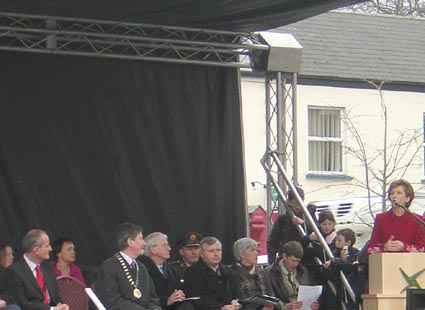
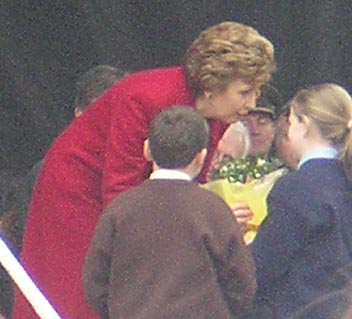
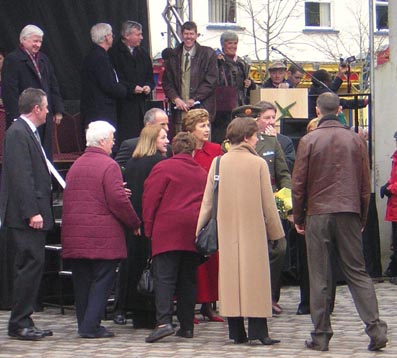
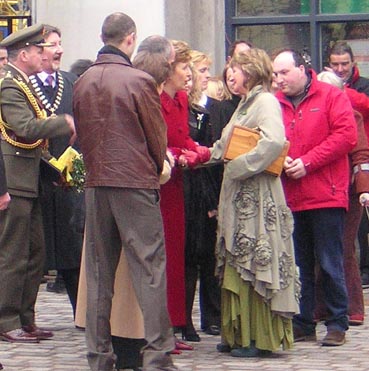
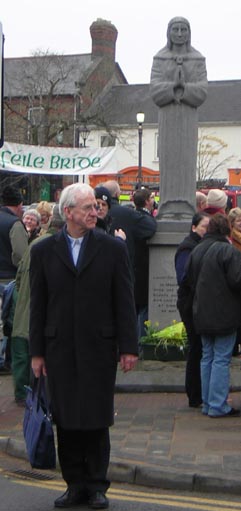
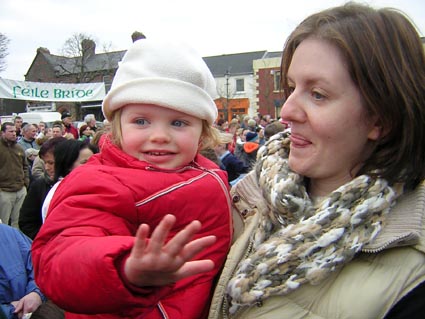
Posted by mariocorrigan at 06:38 PM
January 29, 2006
FEILE BHRIDE - FESTIVAL OF ST. BRIGID 2006
The Annual Feile Bhride Festival is underway in Kildare Town - for full details visit the Solas Bhride website or the kildare.ie website
On Wednesday, 1st February, St. Brigid's Day, a new sculpture will be unveiled by the Irish President, Mary McAleese, on the Market Square, Kildare Town. This sculpture will house the permanent flame to commemorate the inextinguishable fire of St. Brigid which burned in Kildare for centuries.
To commemorate St. Brigid's day and Feile Bhride I am adding a section on St. Brigid to the site and will post 5 articles today relating to St. brigid.
Posted by mariocorrigan at 10:11 PM
September 13, 2005
MEDLICOTTS RETURN TO KILDARE
On Monday I received a phone call from Kildare Town Heritage Centre to say that there were members of the Medlicott family in the Centre with questions about Dunmurray Graveyard where some of their ancestors were buried. After a little conversation we arranged to meet in the graveyard to check out the condition of the graveyard. I am currently working on compiling the graveyard inscriptions of the three Kildare Abbeys and I had intended to take the inscriptions at Dunmurray in 2006 so it was a good opportunity to see the condition of the graveyard firsthand. The graveyard is in surprisingly good condition thanks to the owners of Dunmurray.
The Medlicott party was headed up by Philip Medlicottand and as well as including his sister and brother it included his mother whose husband is buried in the graveyard.
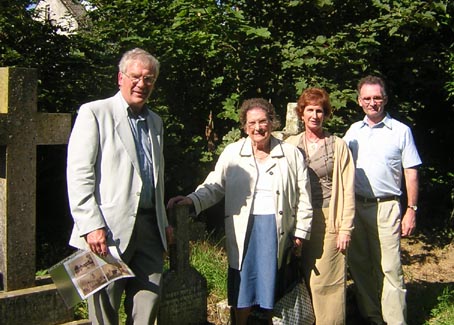
The Medlicott family originally owned Tully also but were most closely associated with Dunmurray and were in Kildare since around 1712. When the family vault in Kildare Cathedral became full members were buried in Dunmurray. Philip maintains a website on the family and has promised to send me on details which I will post on the web. Meanwhile why not try googling MEDLICOTT but make sure to click web and not simply pages from Ireland.
Posted by mariocorrigan at 08:45 PM
August 26, 2005
PHOTOGRAPHIC HISTORY CO. KILDARE
Wednesday 7th Sept. at 7.30 p.m. Riverbank Arts Centre Newbridge
FREE
‘Photographic History of County Kildare, based on photographs taken from the Journal of the County Kildare Archaeological Society’
To promote Heritage Week, the County Kildare Archaeological Society, in association with the History and Family Research Centre, Co. Kildare Library and Arts Service, is hosting a photographic presentation in Riverbank, Newbridge, which will explore some elements of the History of County Kildare.
The aim of the presentation is to promote the heritage, history and archaeology of Co. Kildare and to demonstrate the pivotal role in the protection and promotion of the County’s heritage, played by the Kildare Archaeological Society, from its origins in 1891 down to the present day.
The Society is ever looking towards the future and would welcome non-members as well as members along on the night, particularly younger people. The need to encourage and develop an interest in the heritage and history of the County amongst the younger generations is of prime importance to the Society and the indeed the County Library.
Last year the Kildare Archaeological Society collaborated with the Local Studies Dept., History and Family Research Centre to host a presentation by Mary Ryan on ‘The Clongorey Evictions.’ This proved to be a most successful evening and they have collaborated once more to present a photographic presentation on the history of County Kildare based almost entirely on material taken from the Journal of the County Kildare Archaeological Society. So much material became available in the preparation of the presentation that there has already been talk of another collaboration for Heritage Week in 2006.
ALL are WELCOME and admission is FREE but try and make it early as the night will surely attract a lot of interest from around the County.
Posted by mariocorrigan at 04:19 PM
August 24, 2005
ANNUAL GRAVEYARD MASS GREY ABBEY 22 AUGUST 2005
THE GRAVEYARD MASS, 2005
Although there was a slight chill in the air the sun was still strong. A canopy was erected near the ruin of the old church to protect against all eventualities.
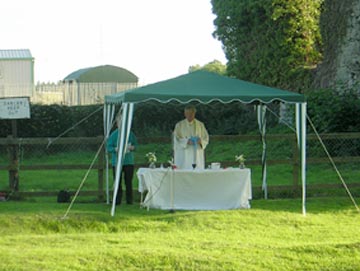 b
b
The mass was celebrated by Fr. Adrian Carbery and was beautifully enhanced by the parish choir.

Fr. Carbery asked people to remember the generations of Kildare people who were buried in the graveyard and the Franciscans who served the local community for hundreds of years at Grey Abbey. He also paid tribute to the Grey Abbey Conservation Project and the men of the CE scheme who keep the graveyard beautifully maintained.
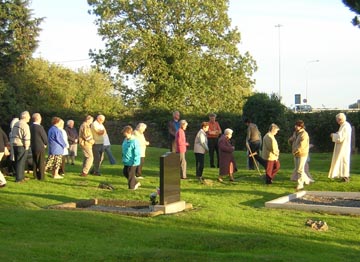
Amongst those present were some visitors from Canada who were introduced to me by Joe Connelly after the Mass. Paul White was in Kildare Town in search of his ancestors and to follow up on information researched by his family over the past few years. His Grandfather was Michael White from Cherryville who is buried at Grey Abbey.
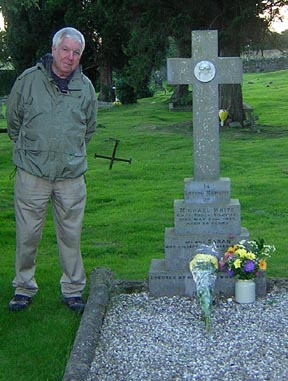
Paul White from Canada beside the grave of his Grandfather, Michael White of Cherryville and Kildare Town.
One of Michael’s sons was Paul’s father who went to Canada, another son was Stephen White who was executed in 1922 on the Curragh during the Civil War. Stephen would have been Paul’s uncle.
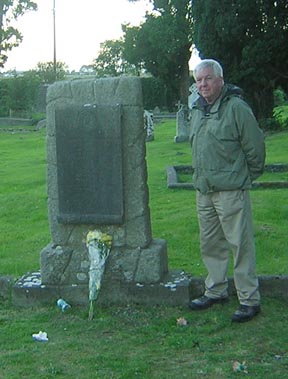
Paul beside the grave of the uncle he never knew, Stephen White who was executed in 1922 during the Irish Civil War.
Paul paid a visit to me in the Local Studies Dept. of Kildare Co. Library the next day and was able to trace his family in the 1901and 1911 Census. They were iron moulders from Cherryville and lived next door to the Fitzgeralds. The site of Fitzgerald’s forge is still a well-known location in the area. Some time after 1911 they moved in to Kildare Town to Grey Abbey St. where before the Civil War young Stephen worked on the railway. No doubt it was here also he came into contact with Patrick Mangan, of Fairgreen, another railway worker and another of those executed in 1922. Their knowledge of the rail timetables and the workings of the railway obviously helped them during their raids on the railway lines and disruption of the Free State communications.
Posted by mariocorrigan at 11:28 PM
July 18, 2005
CLEARANCE OF THE GREY ABBEY TOWNLAND SITE
A shot of the bleak landscape
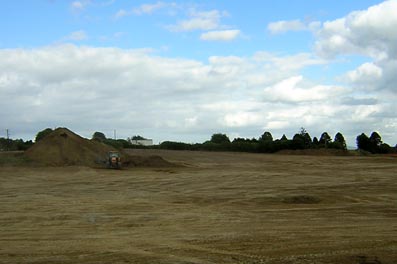
Work continues on the removal of the archaeological remains
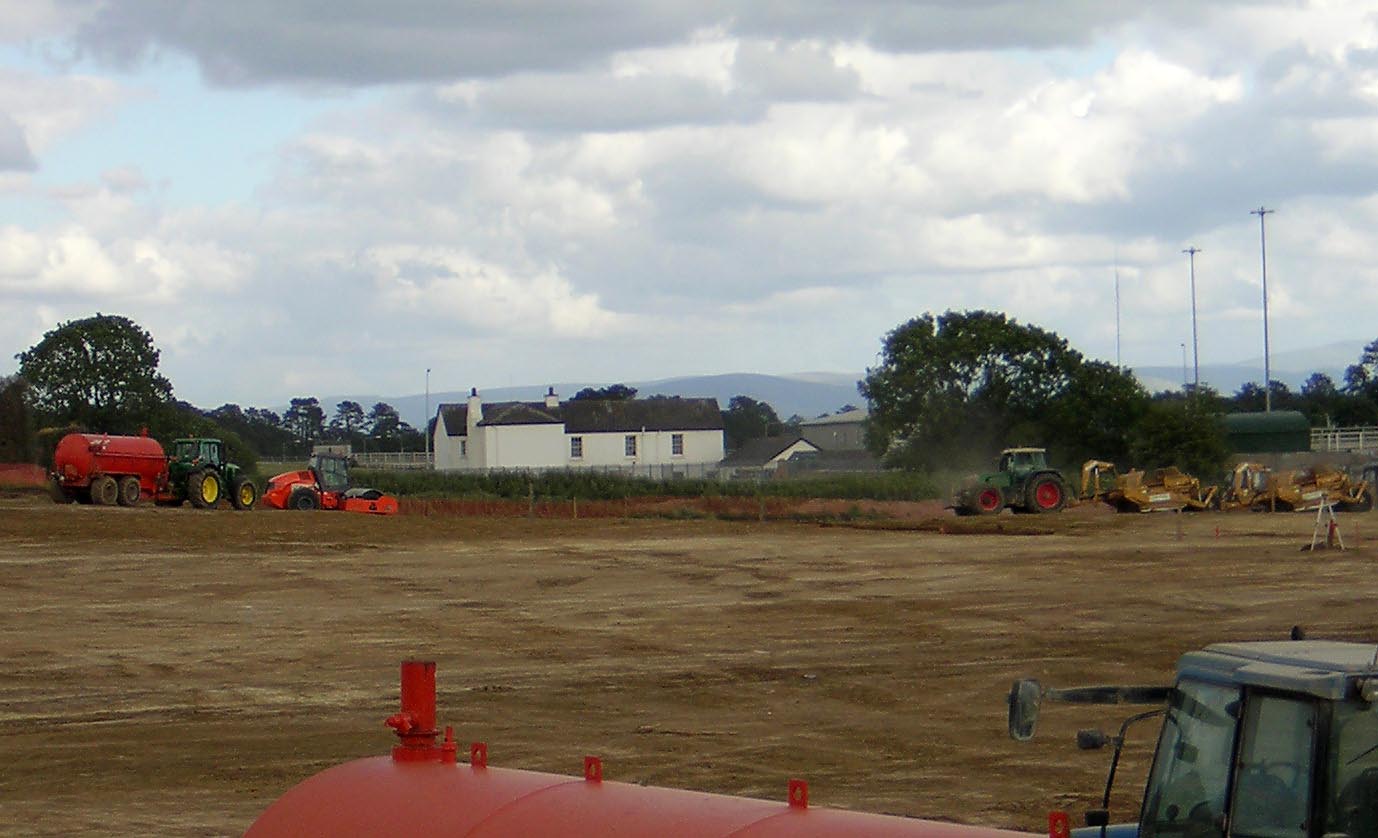
Trucks lining up to take away the topsoil and earth from the site
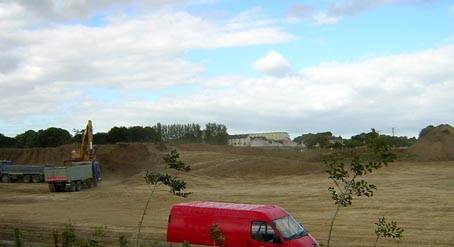
Posted by mariocorrigan at 08:57 PM
July 11, 2005
WORK HAS BEGUN ON THE RETAIL CENTRE AT GREY ABBEY
The diggers are in and work has begun on the development of the Retail Centre at Grey Abbey. The site is being prepared - this is what it looks like after the first full week of work - Sunday 11 July 2005
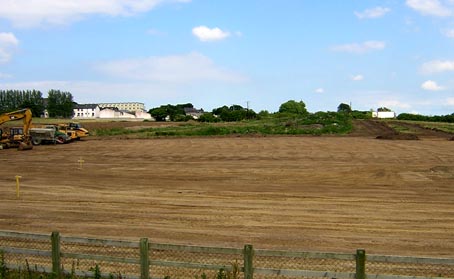
The ancient ruin of the Franciscan Grey Abbey stands witness to yet another change to the nearby landscape
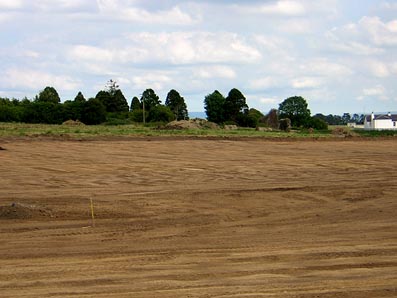
The ancient townland boundary of Grey Abbey is removed to make way for progress
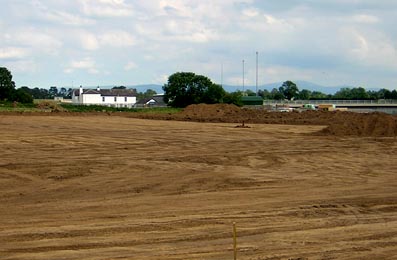
Posted by mariocorrigan at 09:14 PM
DIGGERS AT WORK AT GREY ABBEY TOWNLAND 11 JULY 2005
Diggers at work clearing the old townland boundary 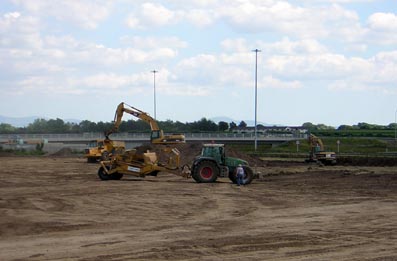
A MOUNTAIN OF EARTH
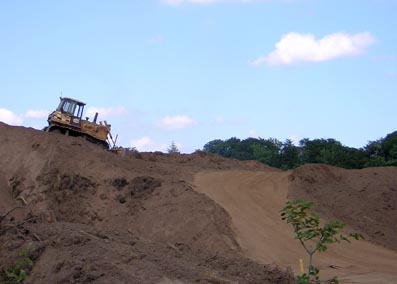
Posted by mariocorrigan at 09:14 PM
July 04, 2005
ALL ABOARD !!!
The Train was on loan for the day fromLullymore Heritage and Discovery Park.
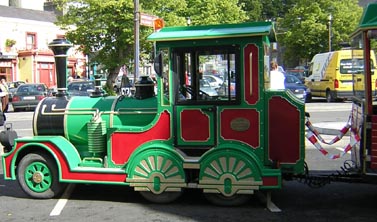
Tour Guide for the day was Adrian Mullowney
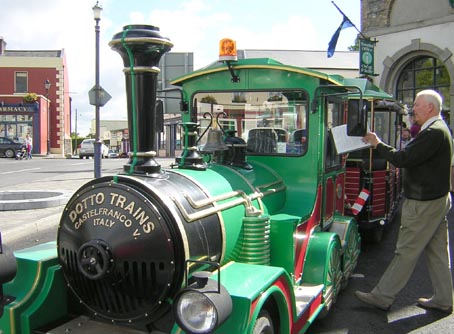
A quick stop at the Curragh Racecourse to stretch the legs.
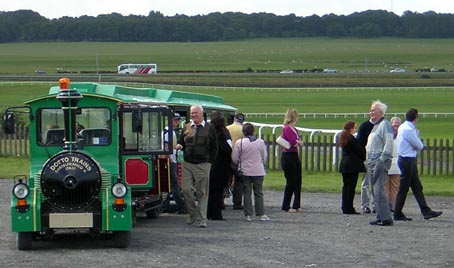
The whole trip lasted about 1hour and 10 minutes and was well received by all who took part. It began and ended in Kildare Town Heritage Centre and the feedback from the group will no doubt help to identify the needs and difficulties facing such a project.
Thanks are due to Mary Stones the manager of the Heritage Centre for all her hard work and to Adrian Mullowney for his commentary as well as Kildare Tourism Task Force - a laudable new initiative for the Town.
Posted by mariocorrigan at 10:40 PM
July 01, 2005
GENERAL VIEW OF THE STANDS FROM ACROSS THE RACECOURSE
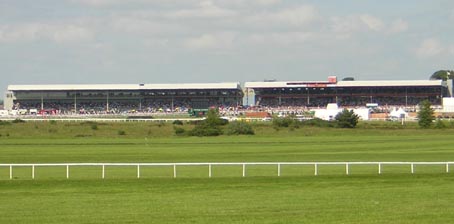
This well-known view of the Curragh is set to change with plans for a new grandstand and new developments planned for the racecourse since the Aga Khan purchsed the Stand House and donated it to the Turf Club.
Posted by mariocorrigan at 09:39 AM
BUDWEISER IRISH DERBY 26 JUNE 2005
The Start of the 2005 Budweiser Irish Derby

Gypsy King shortly after unseating his rider
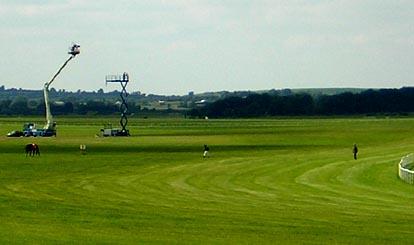
Posted by mariocorrigan at 08:59 AM
June 12, 2005
GORDON BENNETT COMMEMORATION, SUNDAY 5 JUNE 2005
Niamh and John Kelly enjoying the weather and the opportunity of modelling on the running board of one of the lovingly restored cars.
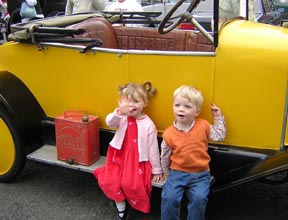
Sunday June 5 saw the commemoration of the Gordon Bennett Race of 1903 with the arrival of vintage and classic cars on the Market Square Kildare Town. This particular part of the weekend long event was organised by Kieran Reid and the local Kildare Vintage and Classic Car Club. It gave locals the opportunity to view these beautiful motor cars close up and some drivers took the opportunity offered by the Representative Church Body to park their 'prize possessions' in the historic grounds of Kildare Cathedral. Triumph, Jaguar, Lotus and Rolls were only some of the more obvious manufacturers names on view. The annual event attracts many visitors from abroad as well as Kildare Laois and Carlow participants and is a welcome attraction for young and old alike.
Posted by mariocorrigan at 07:42 PM
June 05, 2005
A Contribution to the History of Kildare
The Grey Abbey Conservation Project intends to publish on this website articles and images relating not only to the history of Grey Abbey but to the history of Kildare Town. Much of this material will be taken from primary sources such as the newspapers, census, directories etc. but will also include material from other histories of the town.
It is intended to publish an article every week and anybody who has material relating to the history of Kildare Town is welcome to contact us to add it to the site.
The first two articles are snippets taken from The Kildare Observer in 1882 on the courthouse and from The Leinster Leader of 1895 which reported on a Gaelic Football match played at Kildare between the Sons of St. Brigid (forerunners of the Round Towers) and Athgarvan.
Posted by mariocorrigan at 12:22 PM
April 26, 2005
Church Gate Collection
Saturday and Sunday, 16 and 17 April, 2005, saw a tremenduous response to the annual Church Gate Collection in Kildare in aid of Grey Abbey.
The Grey Abbey Conservation Project would like to thank all the collectors
Mario Corrigan, Paddy Newman, Adrian Mullowney, Ger Kelly, Colette Broughall, Margie Sheridan, Kathleen Corrigan, Jimmy Molloy
and all the people of Kildare for their efforts in making the Annual Church Gate Collection a great success. Despite the rain the response from the public was enormous and over €1,050 was raised for the Project.
Posted by mariocorrigan at 07:47 PM





























































 b
b



















